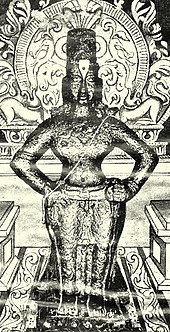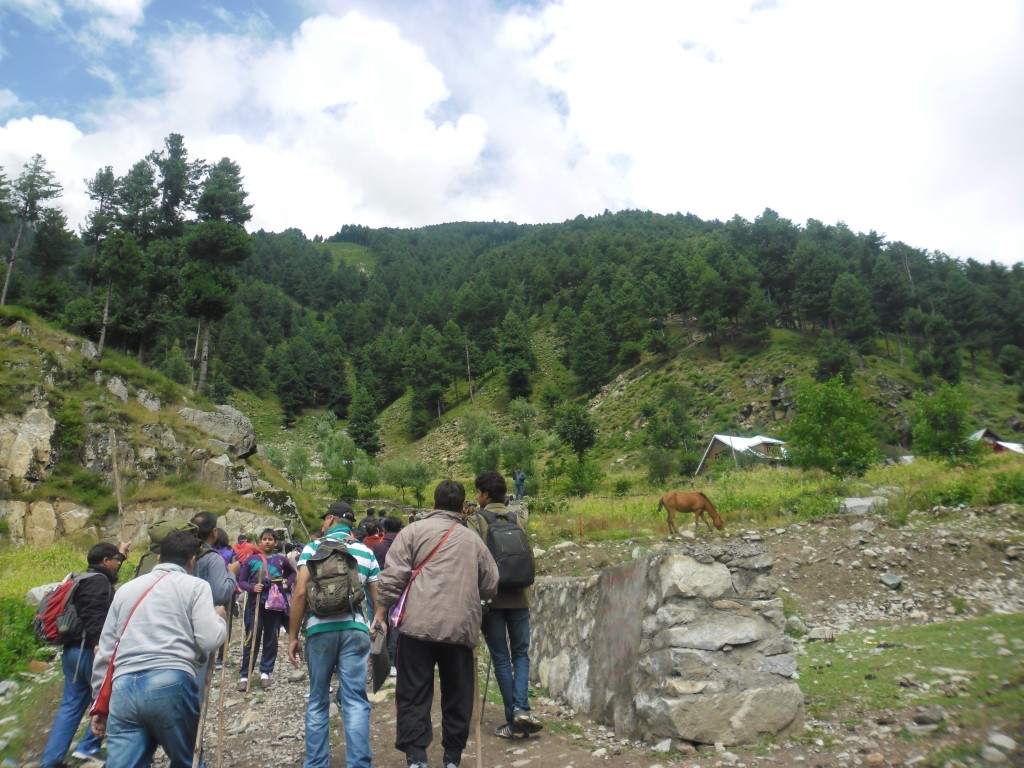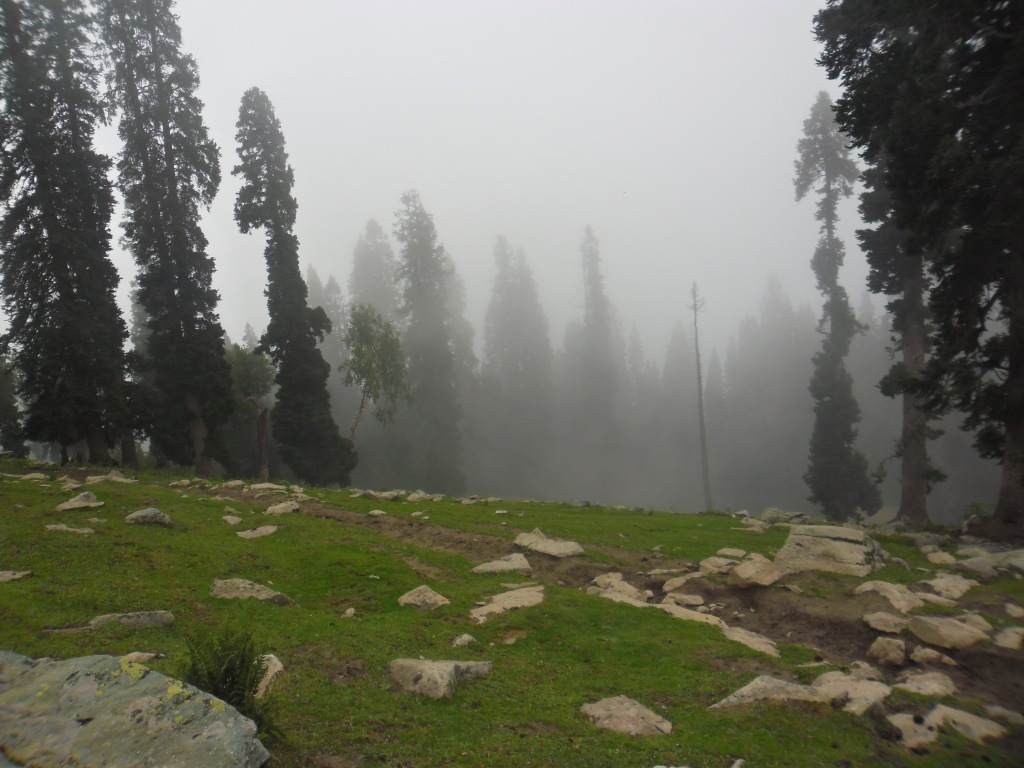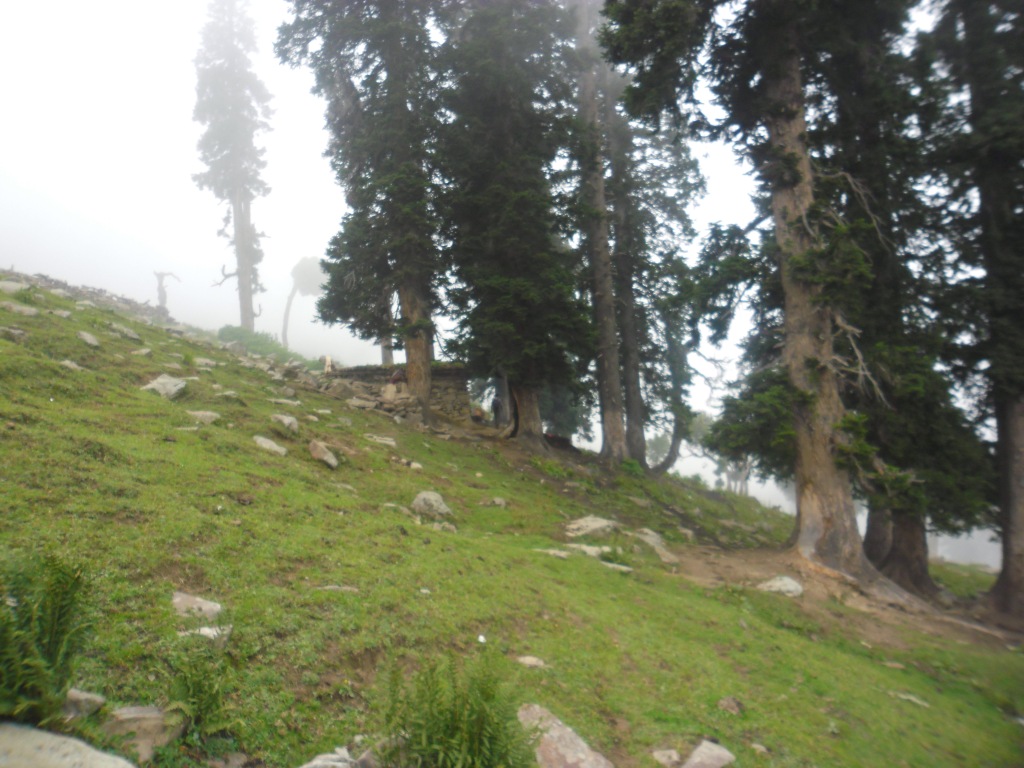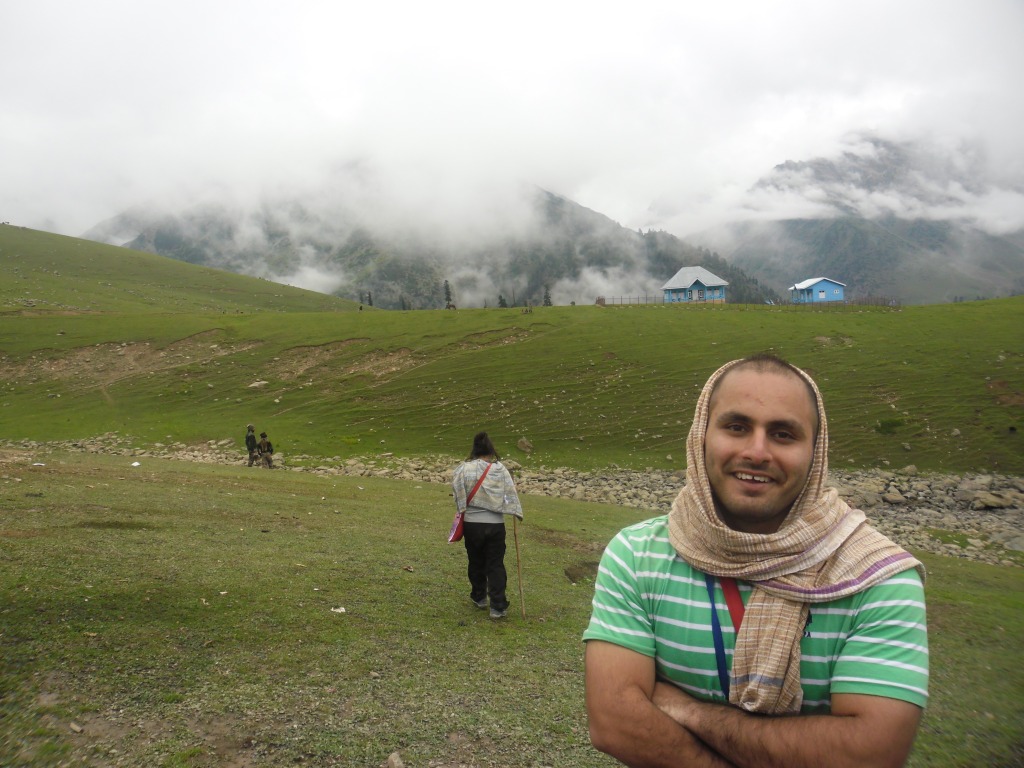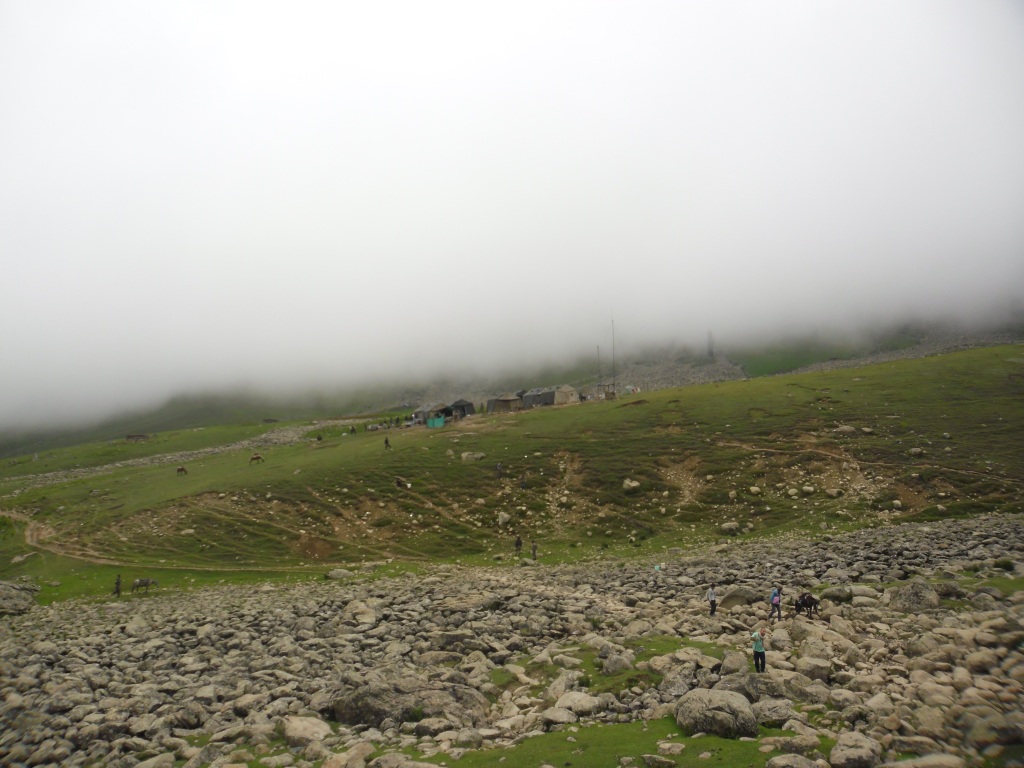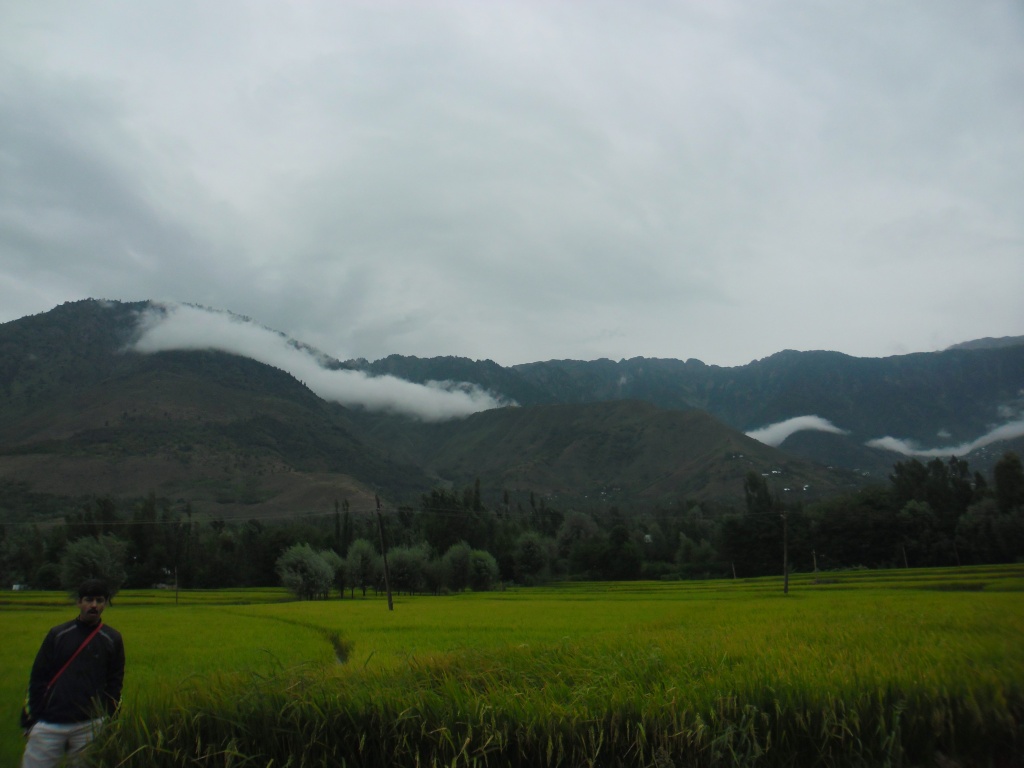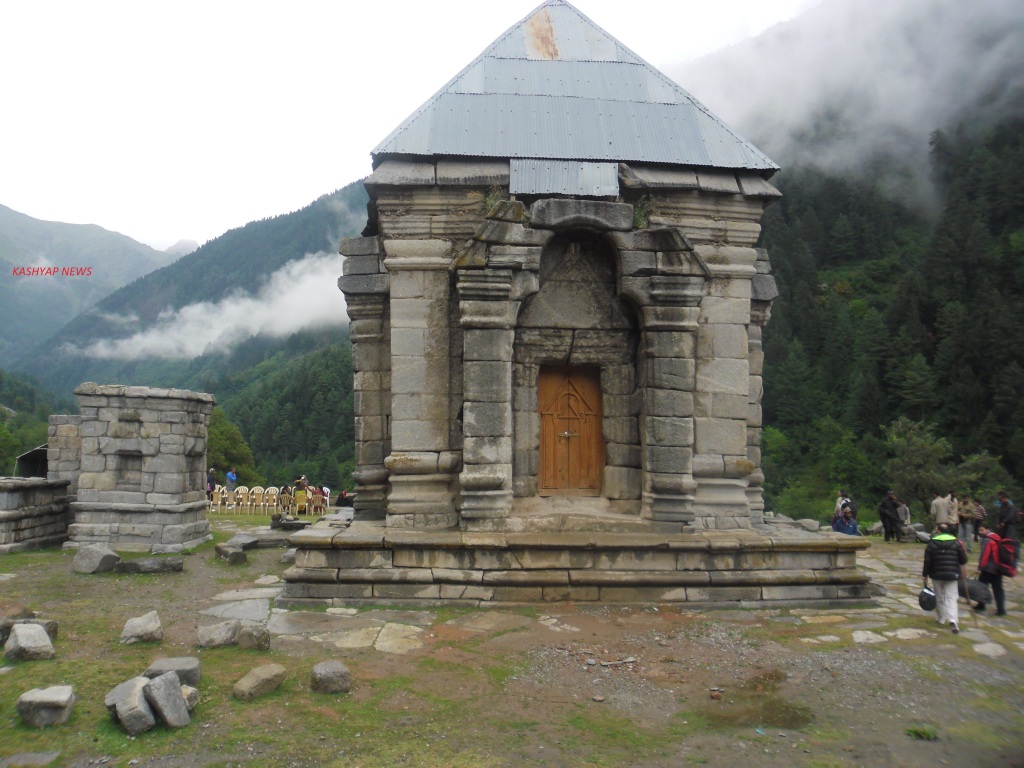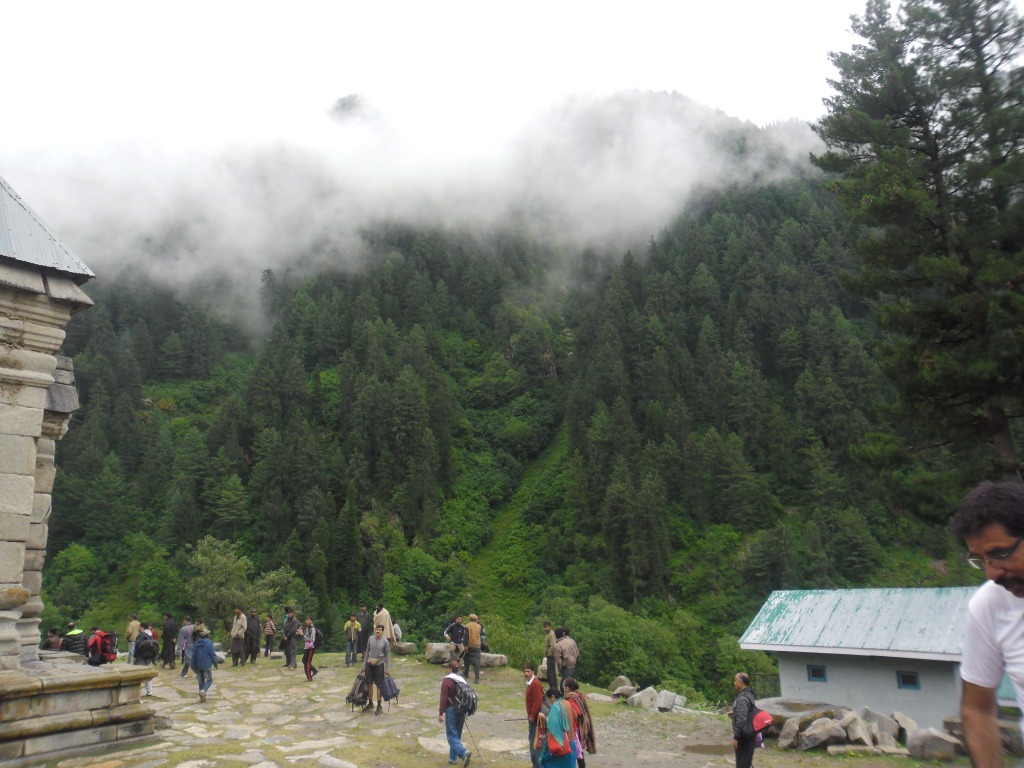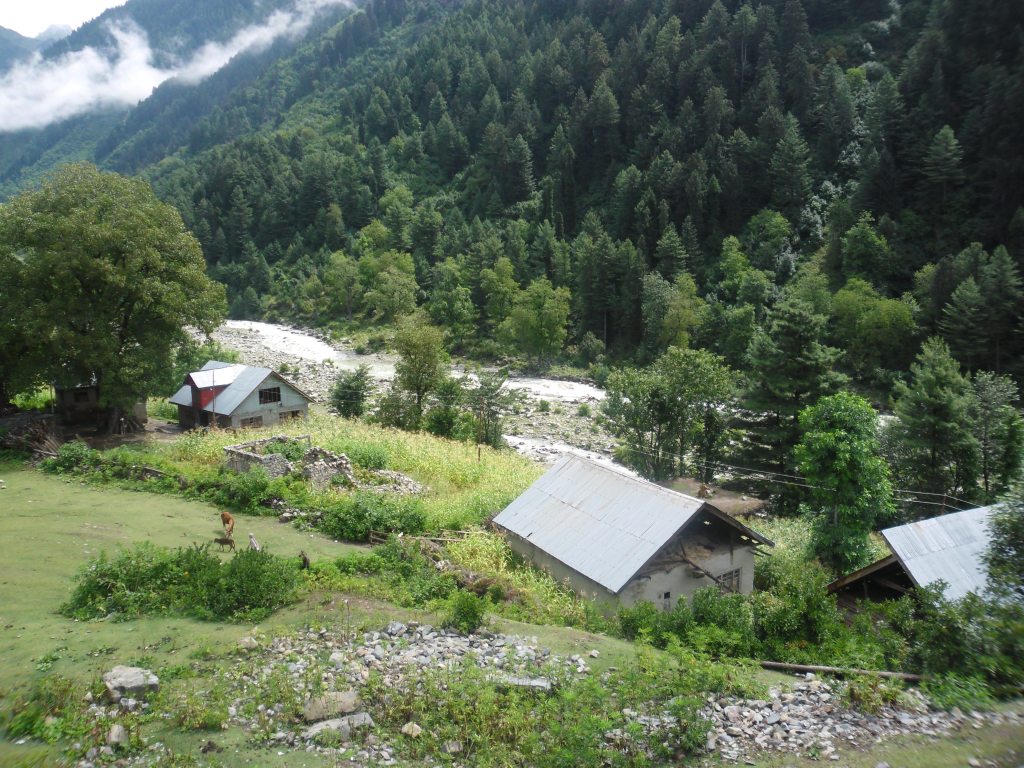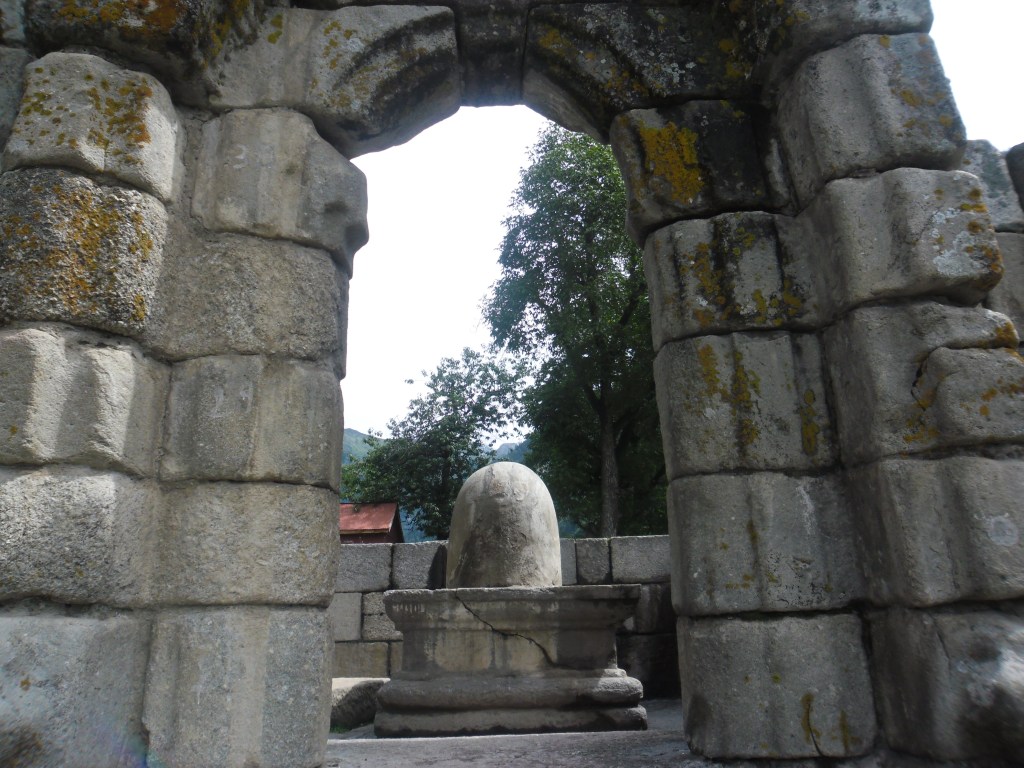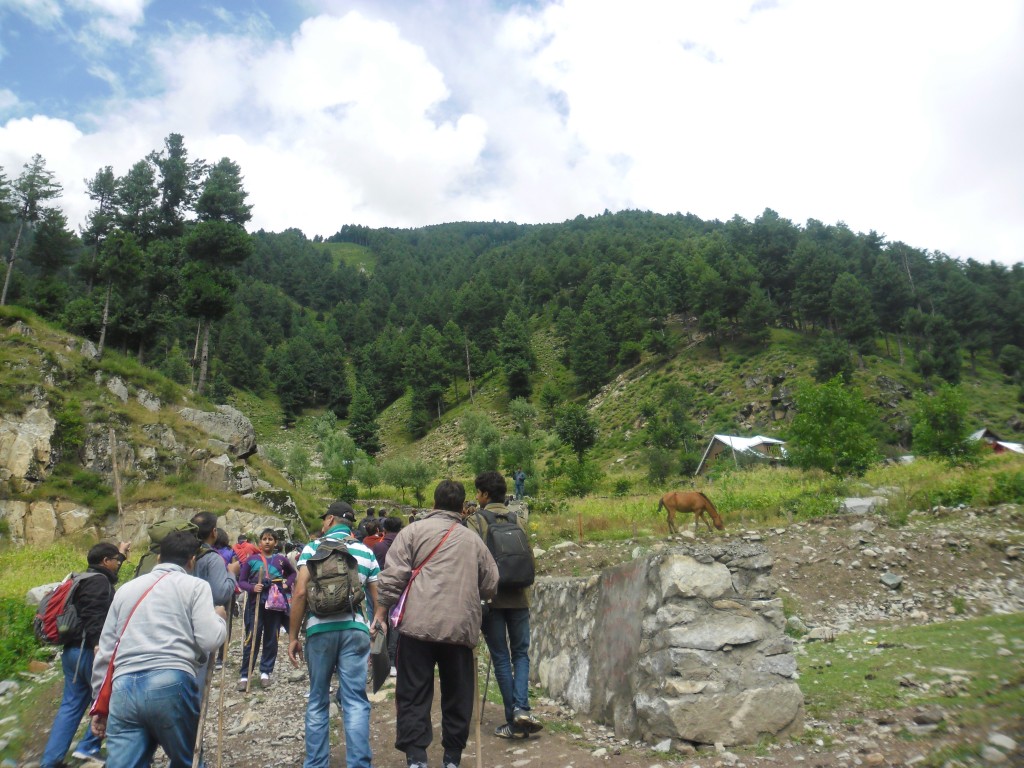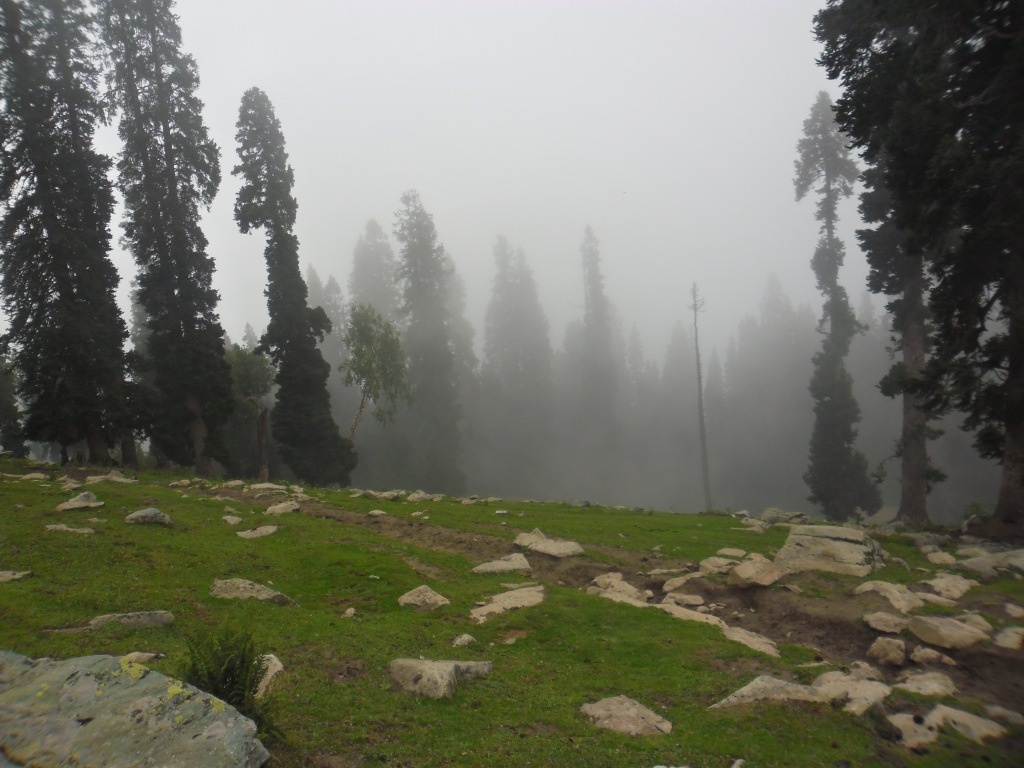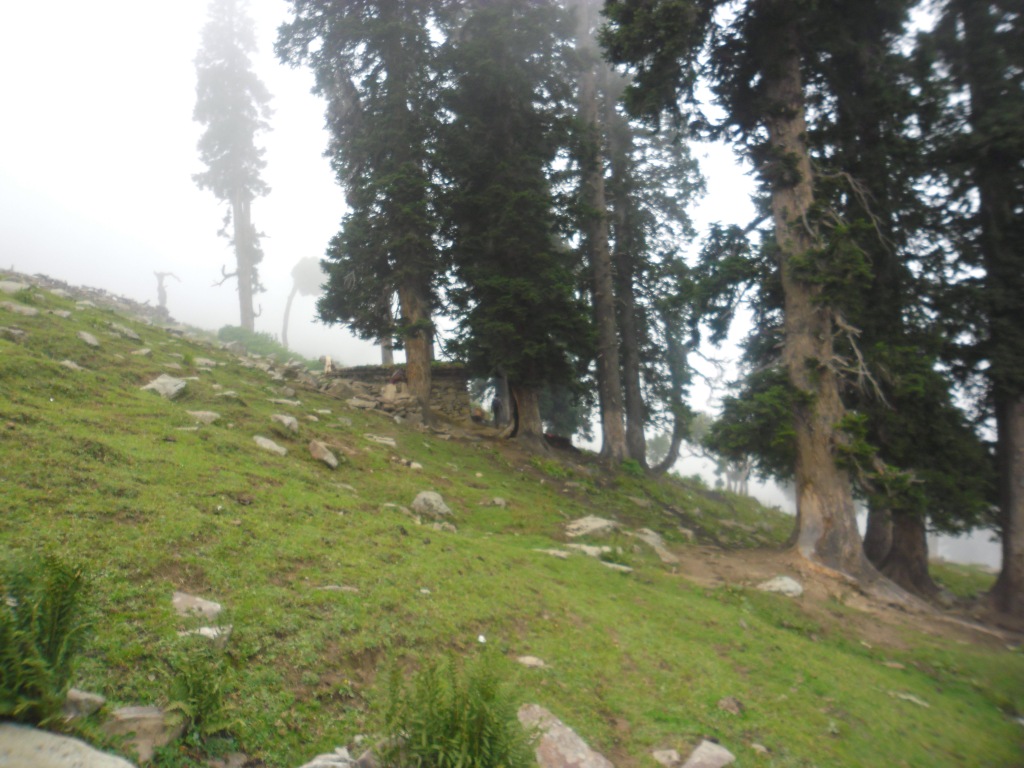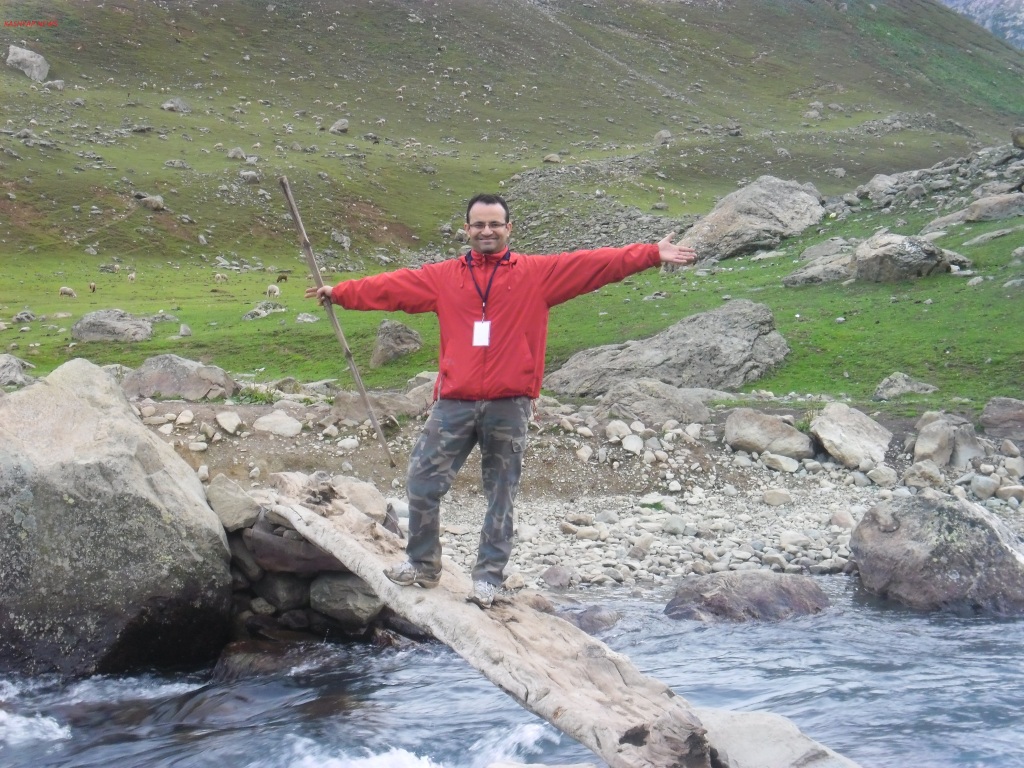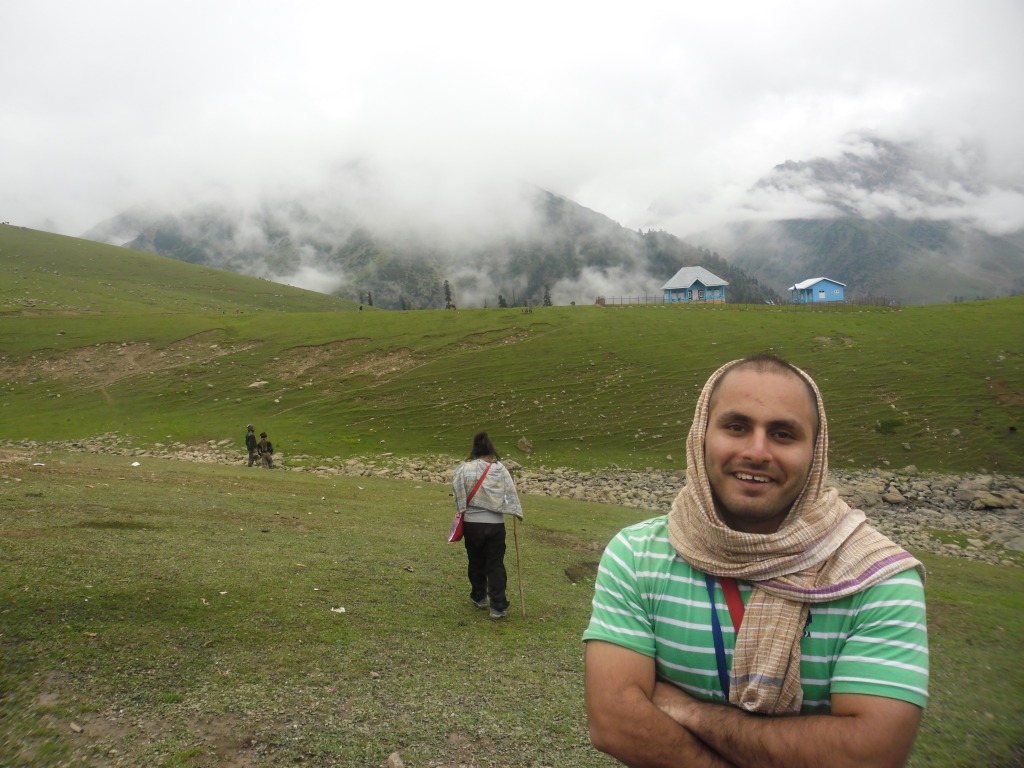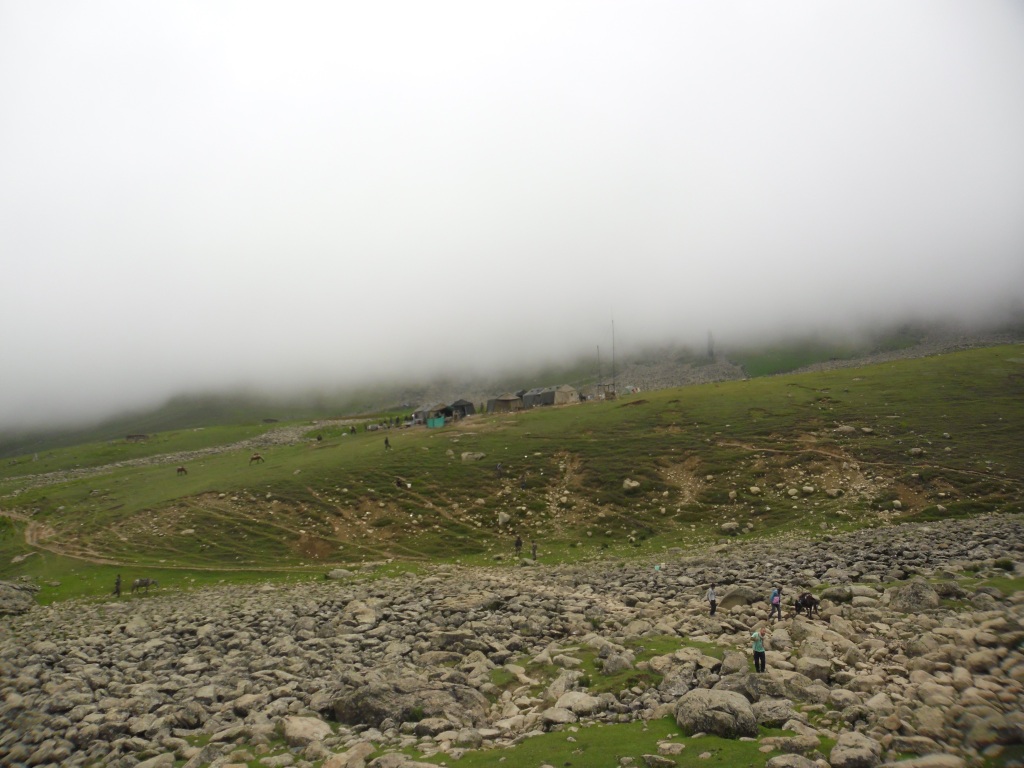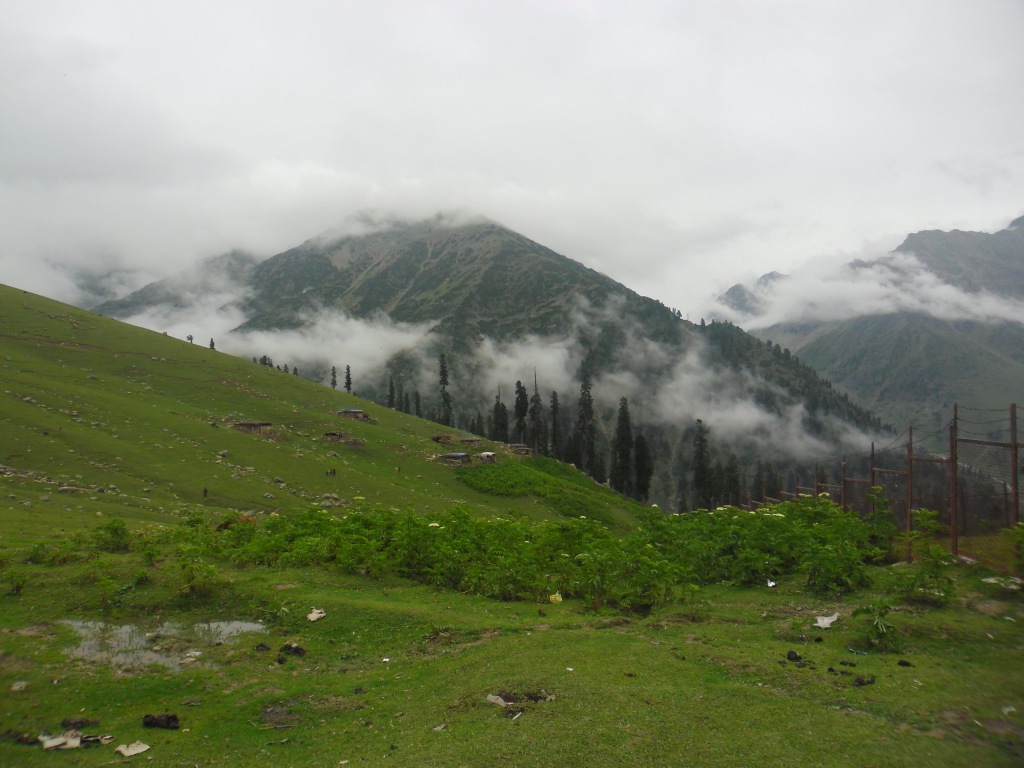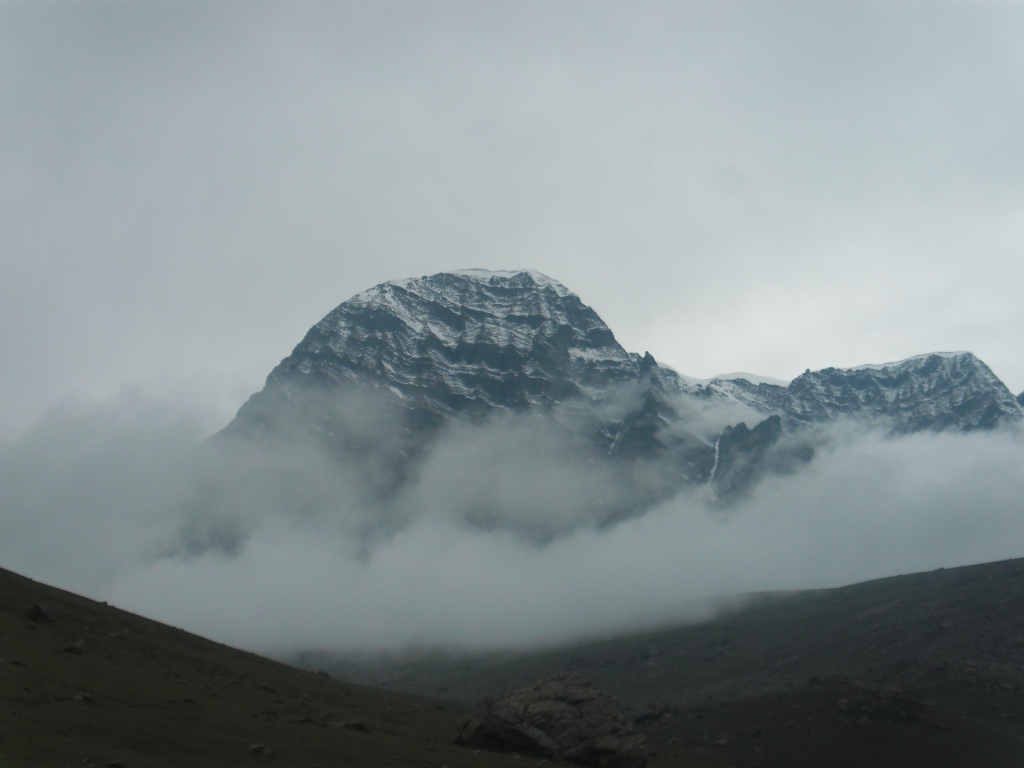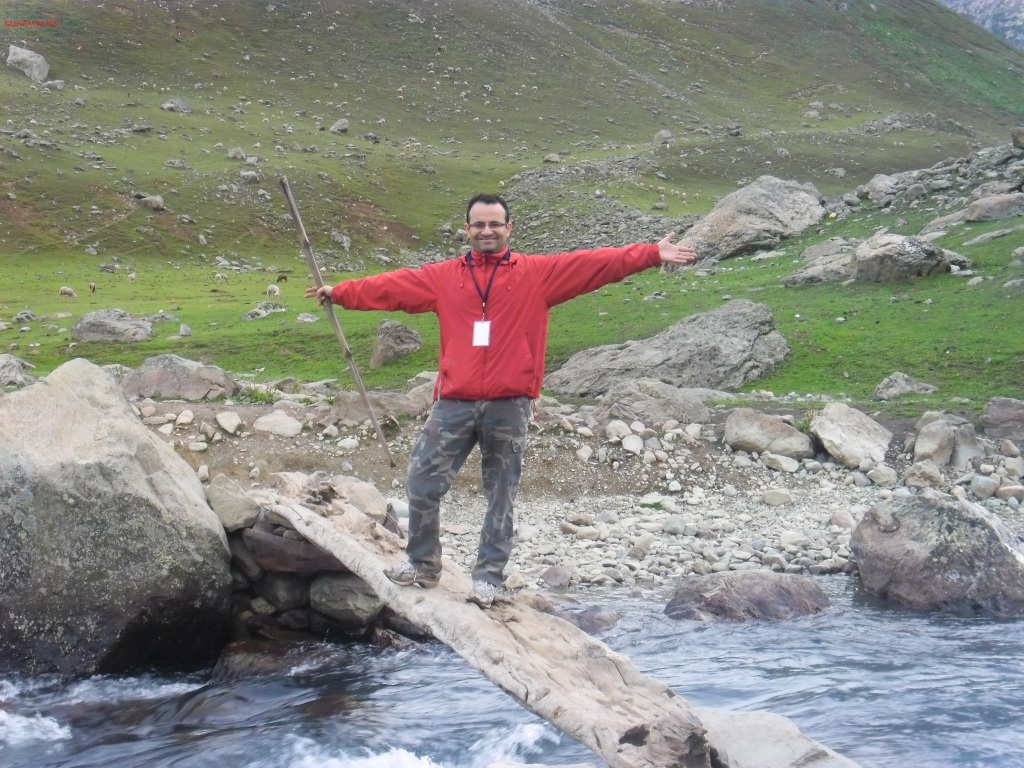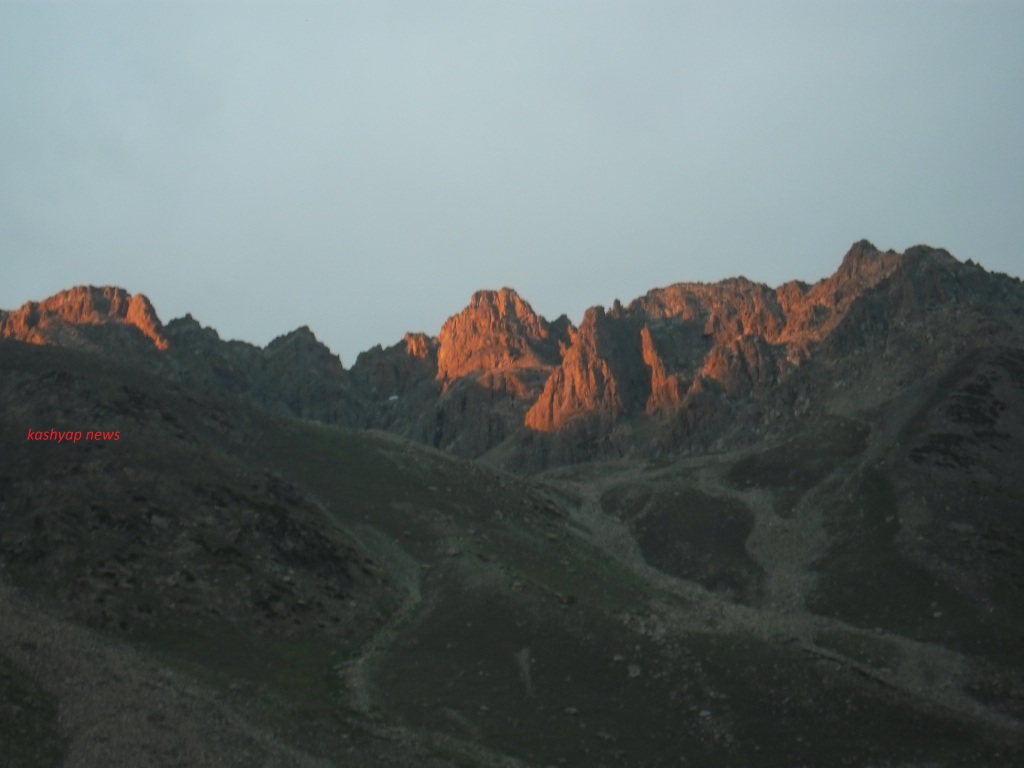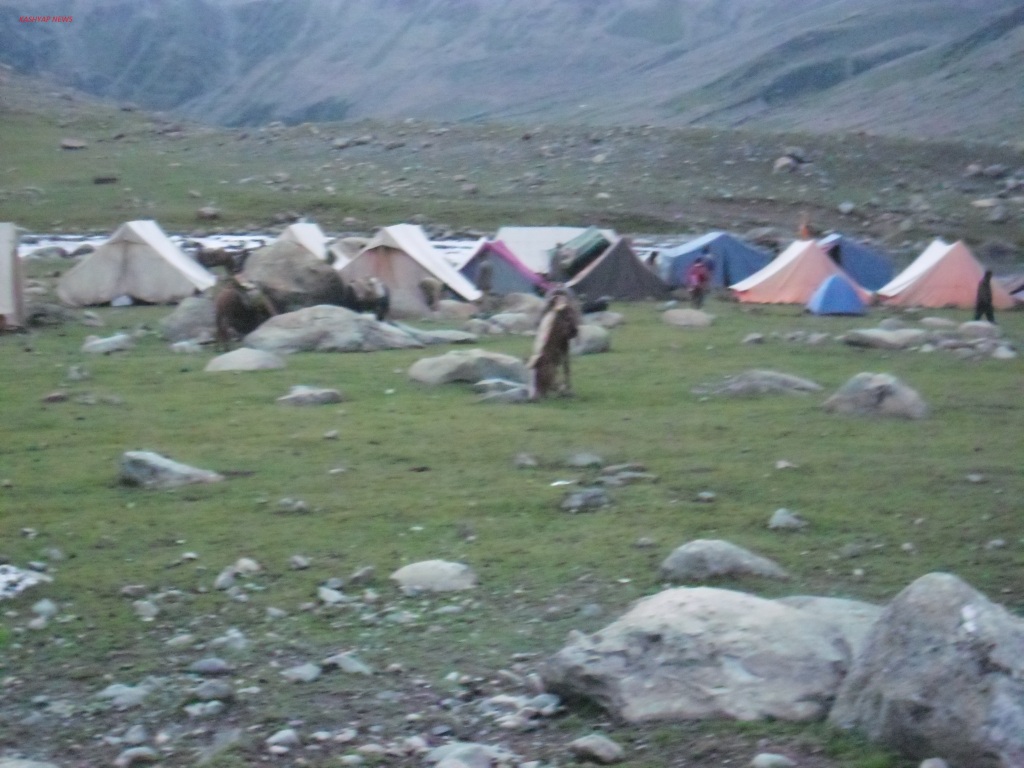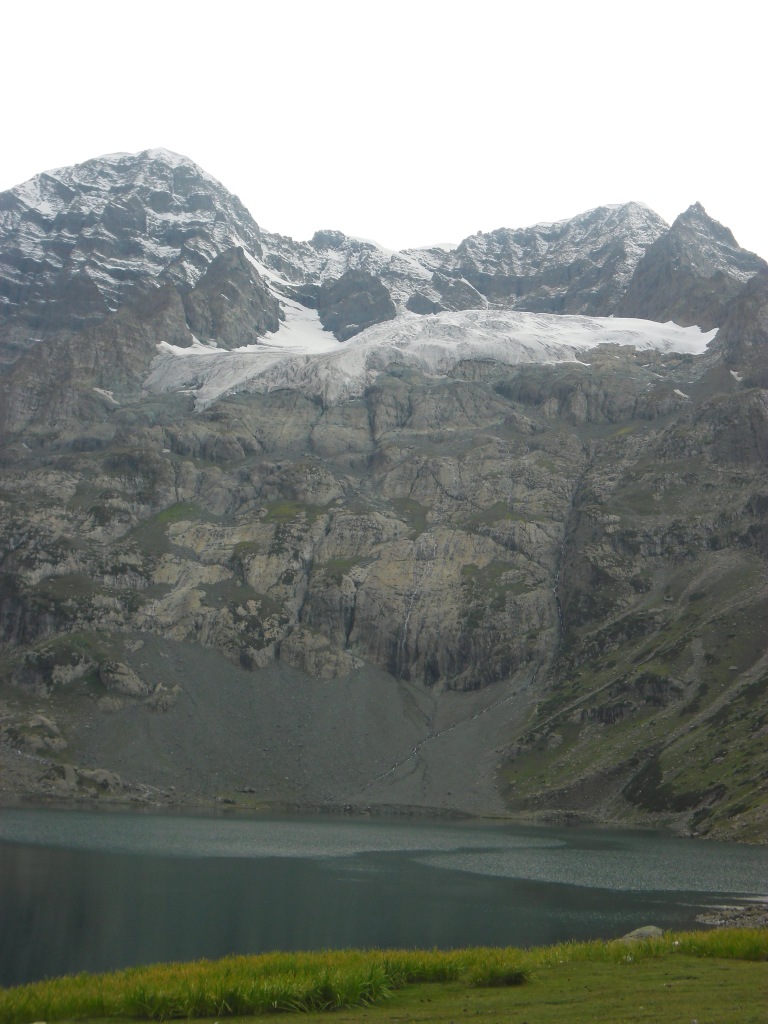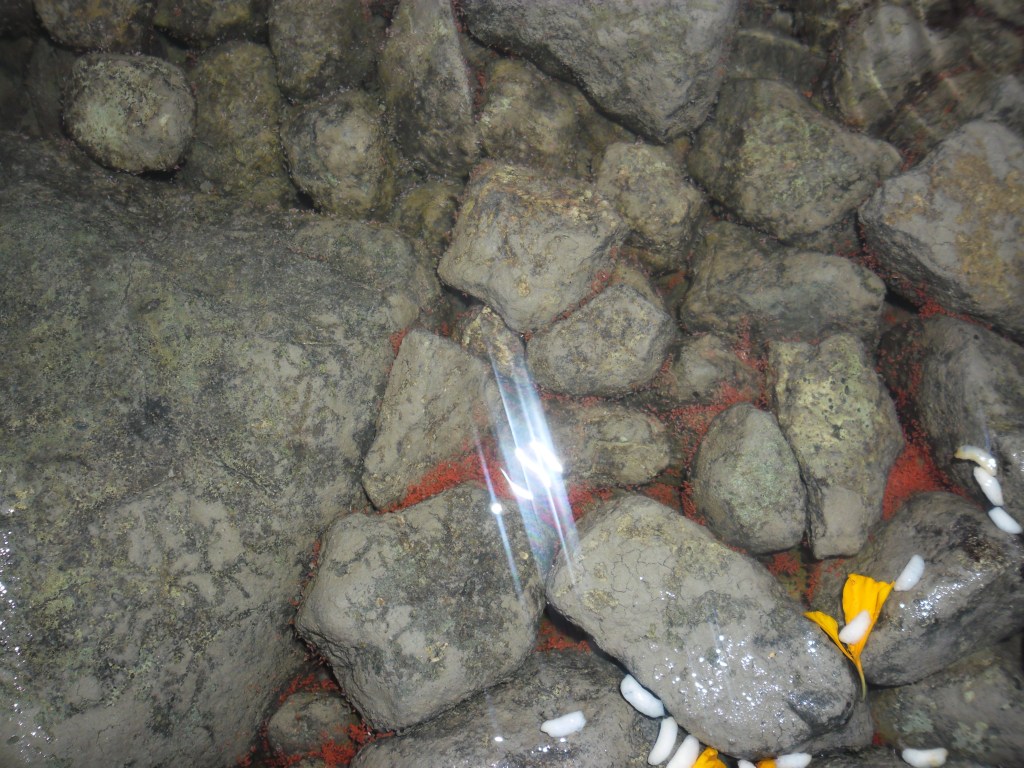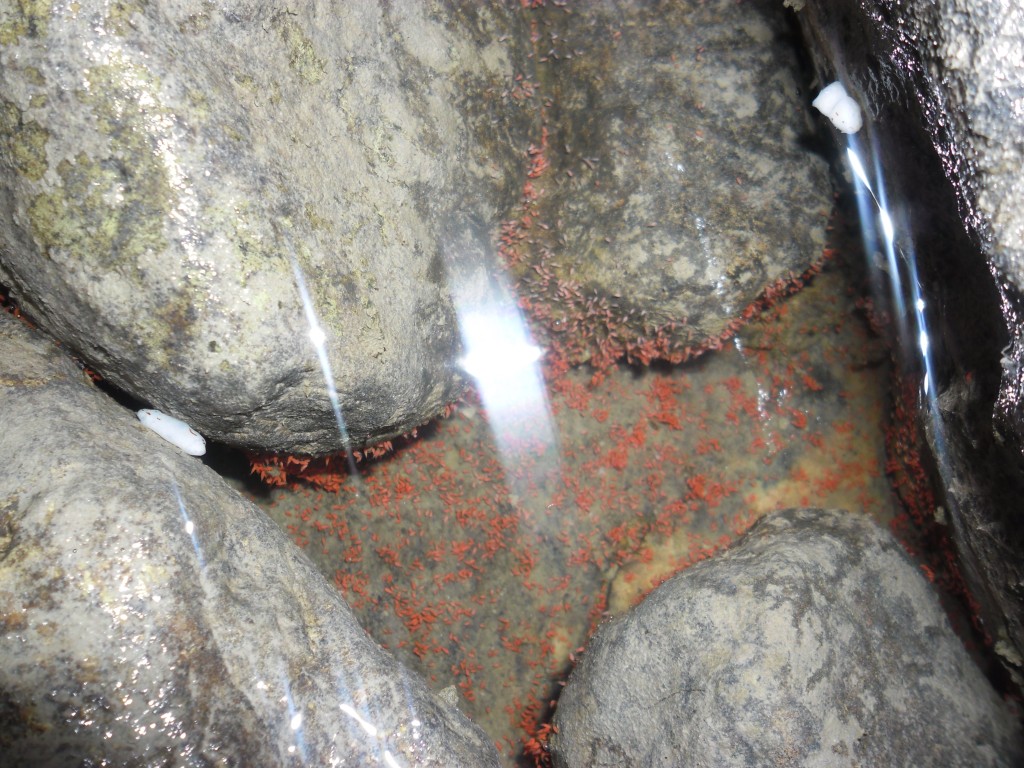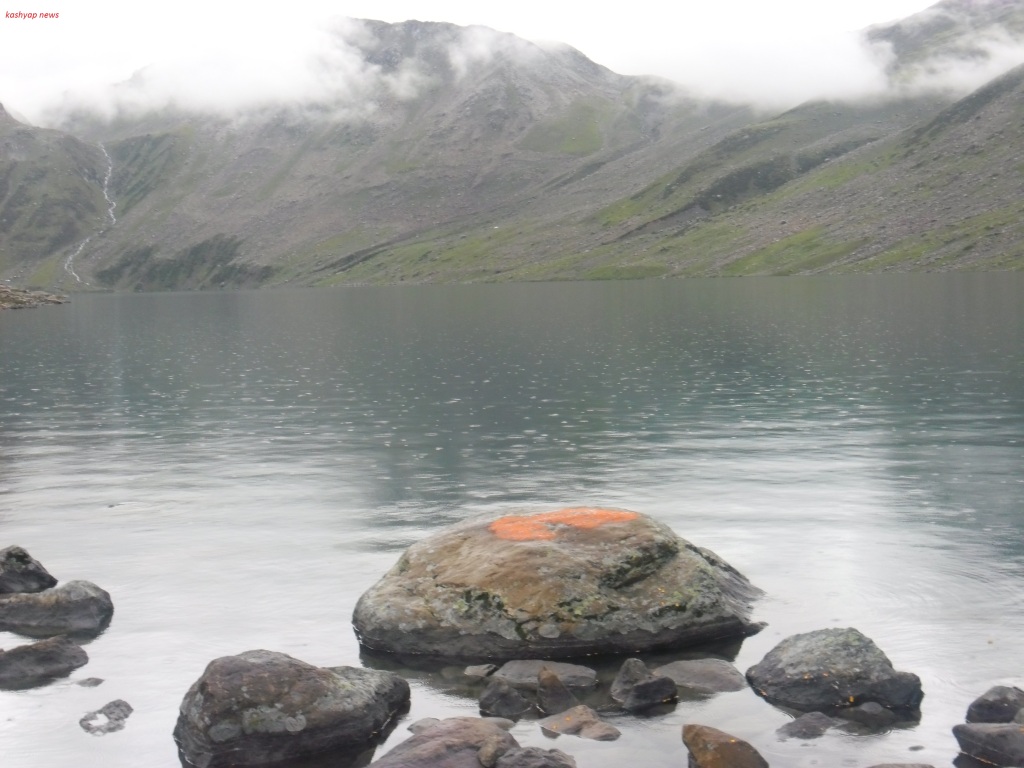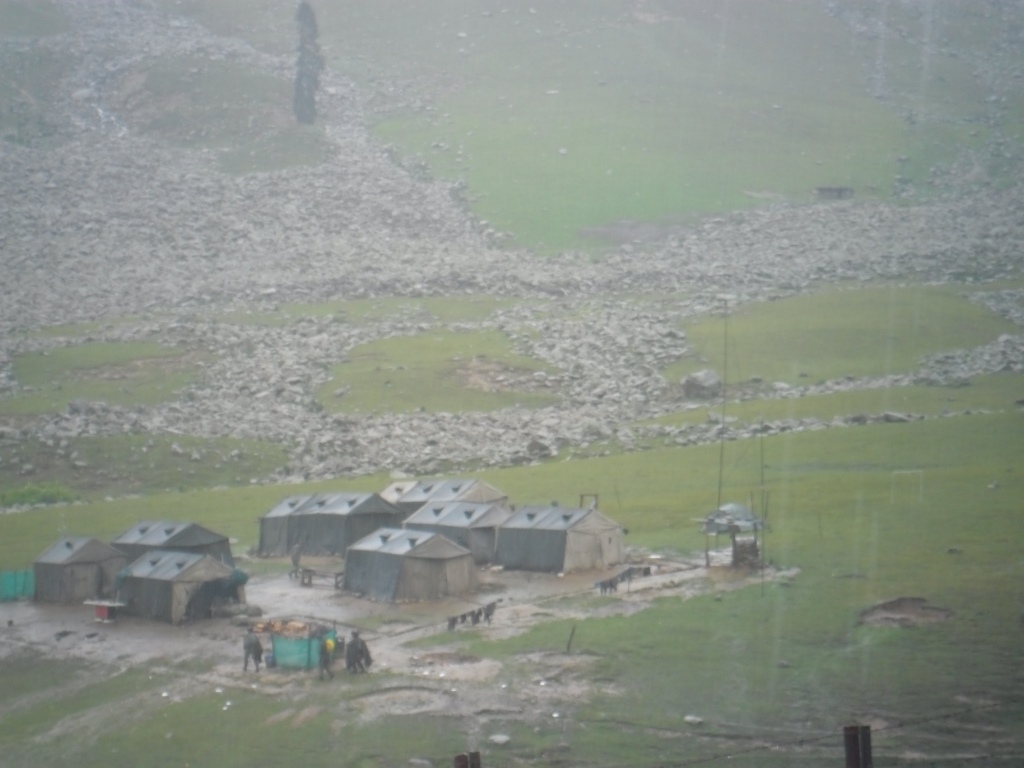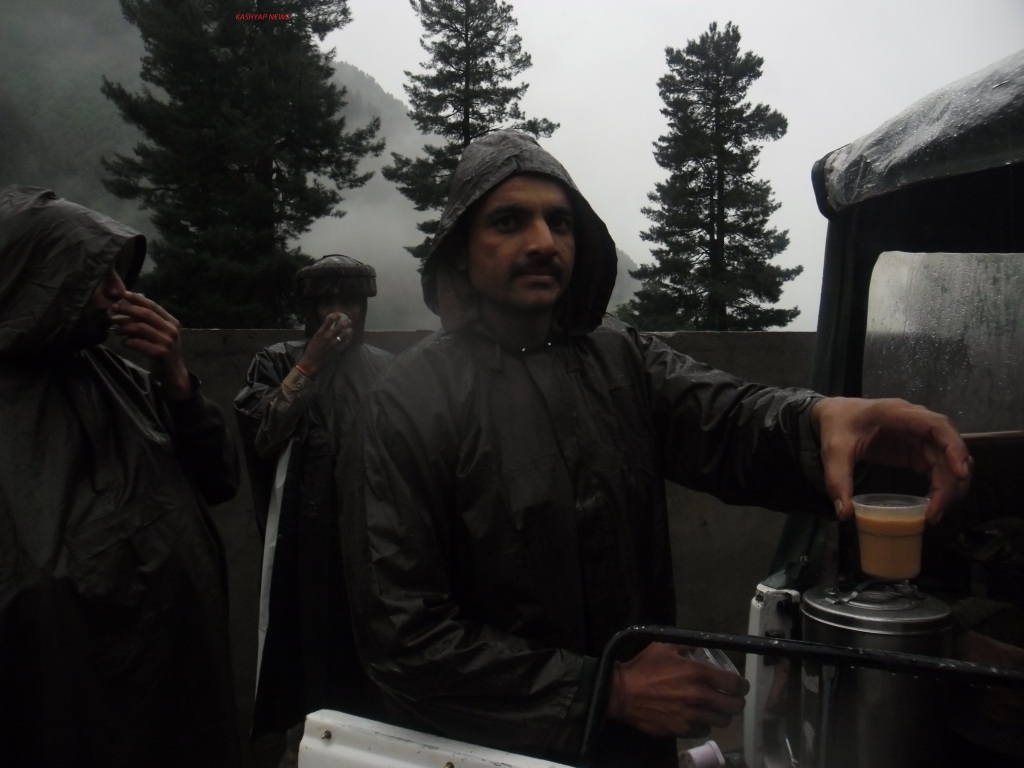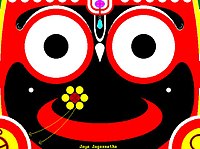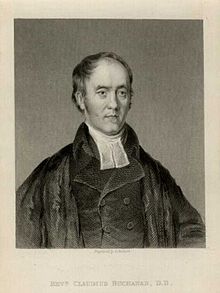Jagannath (
Sanskrit:
जगन्नाथ,
ISO:
Jagannātha;
lit. ''lord of the universe'') is a deity worshipped in regional traditions of
Hinduism and
Buddhism in
India and
Bangladesh. Jagannath is considered a form of
Vishnu.
[1][2] He is part of a triad along with his brother
Balabhadra and sister
Subhadra. To most
Vaishnava Hindus, Jagannath is an abstract representation of
Krishna; to some
Shaiva and
Shakta Hindus, he is a symmetry-filled tantric representation of
Bhairava;
to some Buddhists, he is a symbolic representation of the Buddha in the
Buddha-Sangha-Dhamma triad; to some Jains, his name and his festive
rituals are derived from Jeenanath of
Jainism tradition.
[3]
The icon of Jagannath is a carved and decorated wooden stump with
large round eyes and a symmetric face, and the icon has a conspicuous
absence of hands or legs. The worship procedures, sacraments and rituals
associated with Jagannath are syncretic,
[3] and include rites that are uncommon in Hinduism.
[4]
Unusually, the icon is made of wood and replaced with a new one at
regular intervals. The origin and evolution of Jagannath worship is
unclear.
[5] Some scholars interpret hymn 10.155.3 of the
Rigveda as a possible origin, but others disagree and state that it is a syncretic deity with tribal roots.
[5] His name does not appear in the traditional
Dashavatara (ten avatars) of Vishnu,
[6]
though in certain Odia literature, Jagannath has been treated as the
ninth avatar, as a substitute for or the equivalent of the
Shakyamuni Buddha.
[7]
Jagannath is considered a non-sectarian deity.
[8][9][10] He is significant regionally in the Indian states of
Odisha,
Chhattisgarh,
West Bengal,
Jharkhand,
Bihar,
Gujarat,
Assam,
Manipur and
Tripura.
[11] He is also significant to the Hindus of
Bangladesh. The
Jagannath temple in Puri, Odisha is particularly significant in
Vaishnavism, and is regarded as one of the
Char Dham pilgrimage sites in
India.
[12] The Jagannath temple is massive, over 61 metres (200 ft) high in the
Nagara Hindu temple style, and one of the best surviving specimens of
Kalinga architecture aka Odisha art and architecture.
[13] It has been one of the major pilgrimage destinations for Hindus since about 800 CE.
[13]
The annual festival called the
Ratha yatra
celebrated in June or July every year in eastern states of India is
dedicated to Jagannath. His image, along with the other two associated
deities, is ceremoniously brought out of the sacrosanctum (
Garbhagriha) of his chief temple in Puri (Oriya:
Bada Deula). They are placed in a chariot which is then pulled by numerous volunteers to the
Gundicha Temple,
(located at a distance of nearly 3 km or 1.9 mi). They stay there for a
few days, after which they are returned to the main temple. Coinciding
with the Ratha Yatra festival at Puri, similar processions are organized
at Jagannath temples throughout the world. During the festive public
procession of Jagannath in Puri lakhs of devotees visit Puri to see Lord
Jagganath in chario
Etymology
Jagannath is a
Sanskrit word, compounded of
jagat meaning "universe" and
nātha meaning "Master" or "Lord". Thus,
Jagannath means "lord of the universe".
[15][16]
Jagannatha, according
to them is a generic term, not unique, as much as Lokanatha or
Avalokiteswara. ln fact, the name Jagannatha could be applied to any
Deity which is considered supreme.
— Surendra Mohanty, Lord Jagannatha: the microcosm of Indian spiritual culture[17]
In the
Odia language,
Jagannath is linked to other names, such as
Jagā (ଜଗା) or
Jagabandhu (ଜଗବନ୍ଧୁ) ("Friend of the Universe"). Both names derive from
Jagannath. Further, on the basis of the physical appearance of the deity, names like
Kālya (କାଳିଆ) ("The Black-coloured Lord", but which can also mean "the Timely One"),
Darubrahman (ଦାରୁବ୍ରହ୍ମ) ("The Sacred Wood-Riddle"),
Dāruēdebatā (
ଦାରୁ ଦେବତା "The wooden god"), Chakā ākhi (
ଚକା ଆଖି) or
Chakānayan (
ଚକା ନୟନ "With round eyes"),
Cakāḍōḷā (
ଚକା ଡୋଳା "with round pupils") are also in vogue.
[18][19][20]
According to Dina Krishna Joshi, the word may have origins in the tribal word
Kittung of the
Sora people
(Savaras). This hypothesis states that the Vedic people as they settled
into tribal regions adopted the tribal words and called the deity
Jagannath.
[21] According to O.M. Starza, this is unlikely because
Kittung is phonetically unrelated, and the
Kittung tribal deity is produced from burnt wood and looks very different from Jagannath.
[22]
Iconography
Two versions of Jagannath iconography
The icon of Jagannath in his temples is a brightly painted, rough-hewn log of
neem wood.
[23]
The image consists of a square flat head, a pillar that represents his
face merging with the chest. The icon lacks a neck, ears, and limbs, is
identified by a large circular face symbolizing someone who is
anadi (without beginning) and
ananta (without end).
[24]
Within this face are two big symmetric circular eyes with no eyelids,
one eye symbolizing the sun and the other the moon, features traceable
in 17th-century paintings. He is shown with an
Urdhva Pundra,
the Vaishnava U-shaped mark on his forehead. His dark color and other
facial features are an abstraction of the cosmic form of the Hindu god
Krishna, states Starza.
[25]
In some contemporary Jagannath temples, two stumps pointing forward in
hug-giving position represent his hands. In some exceptional medieval
and modern era paintings in museums outside India, such as in Berlin
states Starza, Jagannath is shown "fully anthropomorphised" but with the
traditional abstract mask face.
[25]
The typical icon of Jagannath is unlike other deities found in
Hinduism who are predominantly anthropomorphic. However, aniconic forms
of Hindu deities are not uncommon. For example, Shiva is often
represented in the form of a Shiva
linga. In most Jagannath temples in the eastern states of India, and all his major temples such as the Puri,
Odisha,
Jagannath is included with his brother Balabhadra and sister Subhadra.
Apart from the principal companion deities, Jagannath icon shows a
Sudarshana Chakra and sometimes under the umbrella cover of multiheaded Sesha Naga, both linking him to
Vishnu.
He was one of the introduction to Hinduism to early European explorers
and merchants who sailed into Calcutta and ports of the
Bay of Bengal. The Italian
Odoric of Pordenone
who was a Franciscan friar, visited his temple and procession in 1321
CE, and described him in the language of the Church. William Burton,
visited his temple at Puri in 1633, spelled him as
Jagarnat and described him to be "in a shape like a serpent, with seven hoods".
[26]
Jagannath
icons are produced from wood. They are replaced every 8 or 12 or 19
years. Above: logs in transport to prepare the Jagannath icon.
When shown with Balabhadra and Subhadra, he is identifiable from his
circular eyes compared to the oval or almond shape of the other two
abstract icons. Further, his icon is dark, while Balabhadra's face is
white, and Subhadra's icon is yellow. The third difference is the flat
head of Jagannath icon, compared to semi-circular carved heads of the
other two.
[27][note 1]
They are accompanied by the Sudarshana Chakra, the iconic weapon of
Vishnu. It is approximately the same height as Balabhadra, is red in
colour, carved from a wooden pillar and clothed, unlike its traditional
representation as a chakra in other Vishnu temples.
[28]
Jagannath iconography, when he is depicted without companions, shows
only his face, neither arms nor torso. This form is sometimes called
Patita Pavana,
[29] or
Dadhi Vaman.
[30]
The
murtis of Jagannath, Balabhadra, Subhadra and Sudarshana Chakra are made of
neem wood.
[31] Neem wood is chosen because the
Bhavishya Purana declares it to be the most auspicious wood from which to make Vishnu
murtis.
[26] The wood icon is re-painted every year before the
Ratha-Yatra. It is replaced with a newly carved image every 12 or 19 years approximately, or more precisely according to the luni-solar
Hindu calendar when its month of Asadha occurs twice in the same year.
[32]
Attributes
Jagannath is considered an
avatar (incarnation) of Vishnu.
[33] Others consider him equivalent to the Hindu metaphysical concept of
Brahman, wherein he then is the Avatarī, i.e., the cause and equivalence of all avatars and the infinite existence in space and time.
[34] According to author Dipti Ray in
Prataparudra Deva, the Suryavamsi King of
Odisha:
In Prataparudradeva's time Odia poets accepted Sarala Dasa's idea and expressed in their literary works as all the Avataras of Vishnu
(Jagannath) manifest from him and after their cosmic play dissolute
(bilaya) in him (Jagannath). According to them Jagannath is Sunnya
Purusa, Nirakar and Niranjan who is ever present in Nilachala to do
cosmic play ... The five Vaishnavite Sakhas ["Comrades"] of Orissa during Prataparudradeva's time expounded in their works the idea that Jagannath (Purushottama) is Purna Brahman from whom other Avataras like Rama, Krishna, etc., took their birth for lilas in this universe and at the end would merge in the self of Purna Brahman.
Images inset: Jagannath (middle),
Subhadra (bottom) and
Balabhadra (top). Jagannath is painted here in an anthropomorphic form, his four hands carrying the same symbols as Vishnu.
In the Jagannath tradition, he has the attributes of all the avatars
of Vishnu. This belief is celebrated by dressing him and worshipping him
as different avatars on special occasions.
[36] However he is most frequently identified with Krishna, the eighth avatar of Vishnu.
[37] The Puranas relate that the
Narasimha Avatar of Vishnu appeared from a wooden pillar. It is therefore believed that Jagannath is worshipped as a wooden
murti or Daru Brahma with the Shri Narasimha hymn dedicated to the Narasimha Avatar.
[38] Every year in the month of
Bhadra, Jagannath is dressed and decorated in the form of the
Vamana avatar of Vishnu.
[34] Jagannath appeared in the form of
Rama, another avatar of Vishnu, to
Tulsidas, who worshipped him as
Rama and called him Raghunath during his visit to
Puri in the 16th century.
[39][40]
Tantric deity
Outside of Vaishnava tradition, Jagannath is considered the epitome of
Tantric worship.
[41] The symmetry in iconography, the use of mandalas and geometric patterns in its rites support the tantric connection proposal.
[3] Jagannath is venerated as
Bhairava or Lord
Shiva, the consort of Goddess Vimala, by
Shaivites and
Shakta sects.
[42] The priests of Jagannath Temple at Puri belong to the Shakta sect, although the Vaishnava sect's influence predominates.
[43] As part of the triad,
Balabhadra is also considered to be Shiva and
Subhadra, a manifestation of
Durga or
Laksmi.
[44] In the
Markandeya Purana the sage
Markandeya declared that Purushottama Jagannath and
Shiva are one.
[45] Jagannath in his Hathi Besha (elephant form) has been venerated by devotees like Ganapati Bhatta of
Maharashtra as the God
Ganesh.
[39]
Origins: alternative theories
Vedic origin of Jagannath
In hymn 10.155 of the
Rig veda, there is mention of a Daru (wooden log) floating in the ocean as
apurusham.
[5][46] Acharya
Sayana interpreted the term
apurusham as same as
Purushottama and this
Dara
wood log being an inspiration for Jagannath, thus placing the origin of
Jagannath in 2nd millennium BCE. Other scholars refute this
interpretation stating that the correct context of the hymn is "Alaxmi
Stava" of Arayi.
[5]
According to Bijoy Misra, Puri natives do call Jagannatha as
Purushottama, consider driftwood a savior symbol, and later Hindu texts
of the region describe the Supreme Being as ever present in everything,
pervasive in all animate and inanimate things. Therefore, while the
Vedic connection is subject to interpretation, the overlap in the ideas
exist.
[13]
Buddhist origins
The
Jagannath festivities in Puri attract crowds with no class or caste
barriers. Some 19th-century writers saw this as one evidence for
Buddhist origins,
[3] now a discredited theory.
[47]
The Buddhist origins theory relies on circumstantial evidence and
colonial era attempts to reconcile empirical observations with the
stereotypical assumptions about Indian religions. For example, there
exists an unexamined relic in the Jagannath shrine in Puri,
[48] and the local legends state that the shrine relic contains a tooth of the
Buddha – a feature common to many cherished Theravada Buddhist shrines in and outside of India.
[13][49]
Other legends state that the shrine also contains bones of the human
incarnation of the Hindu god Krishna, after he was accidentally killed
by a deer hunter. However, in the Hindu tradition, a dead body is
cremated, ashes returned to nature, and the mortal remains or bones are
not preserved or adored.
[50]
In Buddhism, preserving skeletal parts such as "Buddha's tooth" or
relics of dead saints is a thriving tradition. The existence of these
legends, state some scholars such as Stevenson, suggests that Jagannath
may have a Buddhist origin.
[50]
However, this is a weak justification because some other traditions
such as those in Jainism and tribal folk religions too have had
instances of preserving and venerating relics of the dead.
[48]
A circumstantial evidence that links Jagannath deity to Buddhism is the
Ratha-Yatra festival for Jagannath, the stupa-like shape of the temple and a
dharmachakra-like discus (
chakra) at the top of the spire. The major annual procession festival has many features found in the
Mahayana Buddhism traditions.
[13] Faxian (c. 400 CE
[51]),
the ancient Chinese pilgrim and visitor to India wrote about a Buddhist
procession in his memoir, and this has very close resemblances with the
Jagannath festivities. Further the season in which the
Ratha-Yatra
festival is observed is about the same time when the historic public
processions welcomed Buddhist monks for their temporary, annual
monsoon-season retirement.
[50][note 2]
Another basis for this theory has been the observed mixing of
people of Jagannath Hindu tradition contrary to the caste segregation
theories popular with colonial era missionaries and Indologists. Since
caste barriers never existed among devotees in Jagannath's temple, and
Buddhism was believed to have been a religion that rejected caste
system, colonial era Indologists and Christian missionaries such as
Verrier Elwin suggested that Jagannath must have been a Buddhist deity
and the devotees were a caste-rejecting Buddhist community.
[3][54]
According to Starza, this theory is refuted by the fact that other
Indic traditions did not support caste distinctions, such as the Hindu
Smarta tradition founded by
Adi Shankara,
and the traditional feeding of the Hindus together in the region
regardless of class, caste or economic condition in the memory of
Codaganga.
[47] This reconciliation is also weak because Jagannath is venerated by all Hindu sects,
[36] not just
Vaishnavas or a regional group of Hindus, and Jagannath has a pan-Indian influence.
[42][55] The Jagannath temple of Puri has been one of the major pilgrimage destination for Hindus across the
Indian subcontinent since about 800 CE.
[13]
Yet another circumstantial evidence is that Jagannath is sometimes identified with or substituted for
Shakyamuni Buddha, as the ninth avatar of Vishnu by Hindus, when it could have been substituted for any other avatar.
[50] Jagannath was worshipped in Puri by the Odias as a form of
Shakyamuni Buddha from a long time.
Jayadeva, in
Gita Govinda also has described
Shakyamuni Buddha as one among the
Dasavatara. Indrabhuti, the ancient Buddhist king, describes Jagannath as a Buddhist deity in
Jnanasidhi.
[50] Further, as a Buddhist king, Indrabhuti worshipped Jagannath.
[56] This is not unique to the coastal state of Odisha, but possibly also influenced
Buddhism in
Nepal and
Tibet. In Nepal,
Shakyamuni Buddha is also worshipped as Jagannath in Nepal.
[57]
This circumstantial evidence has been questioned because the reverent
mention of Jagannath in the Indrabhuti text may merely be a coincidental
homonym, may indeed refer to
Shakyamuni Buddha, because the same name may refer to two different persons or things.
[56]
Jain origins
Left: Jagannath snana yatra, Right: Dress after the bathing ceremony.
Pandit Nilakantha Das suggested that Jagannath was a deity of
Jain origin because of the appending of
Nath to many Jain
Tirthankars.
[58] He felt Jagannath meant the 'World personified' in the Jain context and was derived from
Jinanath. Evidence of the Jain terminology such as of
Kaivalya, which means
moksha or salvation, is found in the Jagannath tradition.
[59] Similarly, the twenty two steps leading to the temple, called the
Baisi Pahacha, have been proposed as symbolic reverence for the first 22 of the 24 Tirthankaras of Jainism.
[3]
According to Annirudh Das, the original Jagannath deity was influenced by Jainism and is none other than the
Jina of Kalinga taken to
Magadha by
Mahapadma Nanda.
[60] The theory of Jain origins is supported by the Jain
Hathigumpha inscription.
It mentions the worship of a relic memorial in Khandagiri-Udayagiri, on
the Kumara hill. This location is stated to be same as the Jagannath
temple site. However, states Starza, a Jain text mentions the Jagannath
shrine was restored by Jains, but the authenticity and date of this text
is unclear.
[61]
Another circumstantial evidence supporting the Jain origins
proposal is the discovery of Jaina images inside as well as near the
massive Puri temple complex, including those carved into the walls.
However, this could also be a later addition, or suggestive of
tolerance, mutual support or close relationship between the Jains and
the Hindus.
[61]
According to Starza, the Jain influence on the Jagannath tradition is
difficult to assess given the sketchy uncertain evidence, but nothing
establishes that the Jagannath tradition has a Jain origin.
[61]
Vaishnava origins
The Vaishnava origin theories rely on the iconographic details and
the typical presence of the triad of deities, something that Buddhist,
Jaina and tribal origins theories have difficulty in coherently
explaining. The colors, state the scholars of the Vaishnava origin
theory, link to black-colored Krishna and white-colored Balarama. They
add that the goddess originally was Ekanamsa (Durga of Shaiva-Shakti
tradition, sister of Krishna through his foster family). She was later
renamed to Shubhadra (Lakshmi) per Vaishnava terminology for the divine
feminine.
[62]
The weakness of the Vaishnava origins theory is that it conflates
two systems. While it is true that the Vaishnava Hindus in the eastern
region of India worshipped the triad of Balarama, Ekanamsa and Krishna,
it does not automatically prove that the Jagannath triad originated from
the same. Some medieval texts, for example, present the Jagannath triad
as Brahma (Subhadra), Shiva (Balarama) and Vishnu. The historic
evidence and current practices suggest that the Jagannath tradition has a
strong dedication to the
Harihara
(fusion Shiva-Vishnu) idea as well as tantric Shri Vidya practices,
neither of which reconcile with the Vaishnava origins proposal.
[62] Further, in many Jagannath temples of central and eastern regions of India, the Shiva icons such as the
Linga-yoni
are reverentially incorporated, a fact that is difficult to explain
given the assumed competition between the Shaivism and Vaishnavism
traditions of Hinduism.
[62]
Tribal origins
The tribal origin theories rely on circumstantial evidence and
inferences such as the Jagannath icon is non-anthropomorphic and
non-zoomorphic.
[21] The hereditary priests in the Jagannath tradition of Hinduism include non-Brahmin servitors, called
Daitas,
which may be an adopted grandfathered practice with tribal roots. The
use of wood as a construction material for the Jagannath icons may also
be a tribal practice that continued when Hindus adopted prior practices
and merged them with their Vedic abstractions.
[26] The practice of using wood for making
murti is unusual, as Hindu texts on the design and construction of images recommend stone or metal.
[13] The
Daitas are Hindu, but believed to have been the ancient tribe of
Sabaras (also spelled
Soras).
They continue to have special privileges such as being the first to
view the new replacement images of Jagannath carved from wood
approximately every 12 years. Further, this group is traditionally
accepted to have the exclusive privilege of serving the principal meals
and offerings to Jagannath and his associate deities.
[13][22]
According to
Verrier Elwin,
a Christian missionary and colonial era historian, Jagannatha in a
local legend was a tribal deity who was coopted by a Brahmin priest.
[63] The original tribal deity, states Elwin, was
Kittung
which too is made from wood. According to the Polish Indologist Olgierd
M. Starza, this is an interesting parallel but a flawed one because the
Kittung deity is produced by burning a piece of wood and too different in its specifics to be the origin of Jagannath.
[22] According to another proposal by
Stella Kramrisch, log as a symbol of
Anga pen deity is found in central Indian tribes and they have used it to represent features of the Hindu goddess
Kali with it. However, states Starza, this theory is weak because the
Anga pen features a bird or snake like attached head along with other details that make the tribal deity unlike the Jagannath.
[22]
Jagannath (left) may have roots in
Narasimha[64] (right, man-lion avatar of Vishnu who fights evil demon and ends religious persecution).
[65]
Some scholars such as Kulke and Tripathi have proposed tribal deities
such as Stambhesveri or Kambhesvari to be a possible contributor to the
Jagannath triad.
[64]
However, according to Starza, these are not really tribal deities, but
Shaiva deities adopted by tribes in eastern states of India. Yet another
proposal for tribal origins is through the medieval era cult of
Lakshmi-
Narasimha.
[64]
This hypothesis relies on the unusual flat head, curved mouth and large
eyes of Jagannath, which may be an attempt to abstract an image of a
lion's head ready to attack. While the tribal Narasimha theory is
attractive states Starza, a weakness of this proposal is that the
abstract Narasimha representation in the form does not appear similar to
the images of Narasimha in nearby
Konark and
Kalinga temple artworks.
[64]
In contemporary Odisha, there are many Dadhivaman temples with a wooden pillar god, and this may be same as Jagannath.
[66]
Syncretic origins
According to Patnaik and others, Jagannath is a syncretic deity that combined aspects of major faiths like
Saivism,
Saktism,
Vaishnavism,
Jainism, and
Buddhism.
[9][10] Jagannath is worshipped as Purushottama form of Vishnu,
[67] Gaudiya Vaishnavs have identified him strongly with Krishna.
[68] In Gaudiya Vaishnav tradition, Balabhadra is the elder brother
Balaram, Jagannath is the younger brother
Krishna, and Subhadra is the youngest sister.
[69]
Balabhadra considered the elder brother of Jagannath is sometimes identified with and worshipped as
Shiva.
[68] Subhadra now considered Jagannath's sister has also been considered as a deity who used to be
Brahma[68] in some versions and worshipped as Adyasakti
Durga in the form of
Bhuvaneshwari in other versions.
[70] Finally the fourth deity, Sudarsana
Chakra symbolizes the wheel of Sun's Chariot, a syncretic absorption of the
Saura
(Sun god) tradition of Hinduism. The conglomerate of Jagannath,
Balabhadra, Subhadra and Sudarshan Chakra worshipped together on a
common platform are called the Chaturdha Murty or the "Four-fold Form".
[71]
O.M. Starza states that the Jagannath Ratha Yatra may have
evolved from the syncretism of procession rituals for Siva lingas,
Vaishnava pillars, and tribal folk festivities. The
Saiva element in the tradition of Jagannath overlap with the rites and doctrines of
Tantrism and
Shaktism Dharma. According to the
Saivas, Jagannath is Bhairava.
[73] Shiva Purana mentions Jagannatha as one of the 108 names of Shiva.
[74] The tantric literary texts identify Jagannath with Mahabhairav.
[69] Another evidence that supports syncretism thesis is the fact that Jagannath sits on the abstract tantric symbols of
Shri Yantra. Further, his Shri Chakra ("holy wheel") is worshipped in the Vijamantra 'Klim', which is also the Vijamantra of Kali or
Shakti.
The representation of Balaram as Sesanaga or Sankarsana bears testimony
to the influence of Shaivism on the cult of Jagannath. The third deity,
Devi Subhadra, who represents the Sakti element is still worshipped
with the Bhuvaneshwari Mantra.
[73]
The Tantric texts claim Jagannath to their own, to be
Bhairava, and his companion to be same as
Goddess Vimala is the
Shakti. The offerings of Jagannath becomes
Mahaprasad
only after it is re-offered to Goddess Vimala. Similarly, different
tantric features of Yantras have been engraved on the Ratna vedi, where
Jagannath, Balabhadra and Devi Subhadra are set up. The
Kalika Purana depicts Jagannath as a Tantric deity.
[73] According to Avinash Patra, the rituals and special place accepted for non-Brahmin
Daitas
priests in Jagannath tradition, who co-exist and work together with
Brahmin priests suggests that there was a synthesis of Tribal and
Brahmanical traditions.
[3]
According to the Jain version, the image of Jagannath (Black
colour) represents sunya, Subhadra symbolizes the creative energy and
Balabhadra (White colour) represents the phenomenal universe. All these
images have evolved from the Nila Madhava, the ancient Kalinga Jina.
"Sudarshana Chakra" is contended to be the Hindu name of the
Dharma Chakra of Jaina symbol.
[citation needed]
In the words of the historian
Jadunath Sarkar:
[75]
The diverse religions of Orissa in all ages have tended to gravitate towards and finally merged into the Jagannath worship, at least in theory.
Transformation from unitary icon to triad
The
Madala Panji
observes that Neela Madhav transformed into Jagannath and was
worshipped alone as a unitary figure, not as the part of a triad. It is
significant to note that the early epigraphic and literary sources refer
only to a unitary deity
Purushottama Jagannath.
[76]
The Sanskrit play "Anargharaghava" composed by Murari mentioned only
Purushottama Jagannath and his consort Lakshmi with no references to
Blabhadra and Subhadra.
[76]
The Dasgoba copper plated inscription dating to 1198 also mentions only
Purushottama Jagannath in the context that the Puri temple had been
originally built by Ganga king Anantavarman Chodaganga (1078–1147) for
Vishnu and
Lakshmi.
[76] These sources are silent on the existence of Balabhadra and Subhadra. Such state of affairs has led to arguments that
Purushottama
was the original deity and Balabhadra and Subhadra were subsequently
drawn in as additions to a unitary figure and formed a triad.
Balarama,
Subhadra and Jagannath in the temple at Puri, with many human and
sacred figures, buildings and animals. Oil painting by a painter of
Puri, Orissa, ca. 1880/1910.
During the rule of Anangabhima III [1211–1239], Balabhadra and
Subhadra find the earliest known mention in the Pataleshwara inscription
of 1237 CE.
[76]
According to the German Indologist Kulke, Anangibhima III was the
originator of the triad of Jagannath, Balabhadra, and Subhadra
suggesting that Balabhadra was added after
Laksmi's
transformation into Subhadra. According to Bachu Siva Reddy, Triads are
the forms of Mahavishnu and Subhadra is yogamaya and her husband is
Jagannath’s friend Arjun.
[77]
According to Mukerjee, Devi Subhadra could be subsequent addition upon the resurgence of
Shaktism as the consort ("Not sister") of Jagannath.
[78]
Theology
The
theology and rituals associated with the Jagannatha tradition combine
Vedic, Puranic and tantric themes. He is the Vedic Purushottama, the
Puranic Narayana and the tantric Bhairava.
[13] He is same as the metaphysical
Brahman, the form of Vishnu that prevades as abstract
kala (time) in Vaishnava thought. He is abstraction which can be inferred and felt but not seen, just like time. Jagannath is
chaitanya (consciousness), and his companion Subhadra represent
Shakti (energy) while Balabhadra represents
Jnana (knowledge).
[13]
According to Salabega, the Jagannath tradition assimilates the
theologies found in Vaishnavism, Shaivism, Shaktism, Buddhism, Yoga and
Tantra traditions.
[79]
Love and compassion
The Jagannath theology overlaps with those of Krishna. For example, the 17th-century Oriya classic
Rasa kallola
by Dina Krushna opens with a praise to Jagannath, then recites the
story of Krishna with an embedded theology urging the pursuit of
knowledge, love and devotion to realize the divine in everything.
[80] The 13th-century
Jagannatha vijaya
in Kannada language by Rudrabhatta is a mixed prose and poetry style
text which is predominantly about Krishna. It includes a canto that
explains that "Hari (Vishnu), Hara (Shiva) and Brahma" are aspects of
the same supreme soul. Its theology, like the Oriya text, centers around
supreme light being same as "love in the heart".
[81] The 15th-century Bhakti scholar
Shankaradeva of
Assam
became a devotee of Jagannatha in 1481, and wrote love and compassion
inspired plays about Jagannatha-Krishna that influenced the region and
remain popular in Assam and Manipur.
[82]
Shunya Brahma
The
medieval era Oriya scholars such as Ananta, Achyutananda and Chaitanya
described the theology of Jagannath as the "personification of the
Shunya, or the void", but not entirely in the form of Shunyata of
Buddhism. They state Jagannath as "Shunya Brahma", or alternatively as
"Nirguna Purusha" (or "abstract personified cosmos"). Vishnu avatars are
descend from this Shunya Brahma into human form to keep dharma.
[83][84]
Jagannath in Hindu texts and traditions
Although Jagannath has been identified with other traditions in the past, He is now identified more with Vaishnav tradition.
Vaishnavite version
Adhara paaana of Jagannath
The Skanda Purana and
Brahma Purana have attributed the creation of the Jagannathpuri during the reign of
Indradyumna, a pious king and an ascetic who ruled from
Ujjain. According to the second legend, associated with the
Vaishnavas,
when Lord Krishna ended the purpose of his Avatar with the illusionary
death by Jara and his "mortal" remains were left to decay, some pious
people saw the body, collected the bones and preserved them in a box.
They remained in the box till it was brought to the attention of
Indrdyumna by Lord Vishnu himself who directed him to create the image
or a
murti of Jagannath from a log and consecrate the bones of Krishna in its belly. Then King Indradyumna, appointed
Vishwakarma, the architect of gods, a
divine
carpenter to carve the murti of the deity from a log which would
eventually wash up on the shore at Puri. Indradyumna commissioned
Vishwakarma (also said to be the divine god himself in disguise) who
accepted the commission on the condition that he could complete the work
undisturbed and in private.
[85]
Everyone was anxious about the divine work, including the King
Indradyumna. After a fortnight of waiting, the King who was anxious to
see the deity, could not control his eagerness, and he visited the site
where Vishwakarma was working. Soon enough Vishwakarma was very upset
and he left the carving of the idol unfinished; the images were without
hands and feet. The king was very perturbed by this development and
appealed to Brahma to help him. Brahma promised the King that the images
which were carved would be deified as carved and would become famous.
Following this promise, Indradyumna organized a function to formally
deify the images, and invited all gods to be present for the occasion.
Brahma presided over the religions function as the chief priest and
brought life (soul) to the image and fixed (opened) its eyes. This
resulted in the images becoming famous and worshipped at Jagannath Puri
in the well known Jagannath Temple as a Kshetra (pilgrimage centre). It
is, however, believed that the original images are in a pond near the
temple.
[85]
Stories from the Ramayana and Mahabharata
According to Prabhat Nanda, the
Valmiki Ramayana mentions Jagannath.
[86] Some believe that the mythical place where King
Janak performed a
yajna and tilled land to obtain
Sita is the same as the area in which the Gundicha temple is situated in Puri, according to Suryanarayan Das.
[87] The
Mahabharata, states Das, describes King
Indradyumna's Ashvamedh Yajna and the advent of the four deities of the Jagannath cult.
[87]
Sarala Dasa Mahabharata version
Sarala
Dasa, the great Odia poet of the 15th century while praising Jagannath
as the saviour of mankind considered him both as a form of Buddha as
well as a manifestation of Krishna.
[88]
Kanchi conquest
A pictorial representation of Kanchi legend.
One of the most popular legends associated with Jagannath is that of
Kanchi Avijana (or "Conquest of
Kanchi"), also termed as "Kanchi-Kaveri". According to the legends,
[89] the daughter of the King of Kanchi was betrothed to the
Gajapati
of Puri. When the Kanchi King witnessed the Gajapati King sweeping the
area in front of where the chariots of Jagannath, Balabhadra and
Subhadra were kept during Ratha yatra, he was aghast. Considering the
act of sweeping unworthy of a King, the King of Kanchi declined the
marriage proposal, refusing to marry his daughter to a 'Sweeper'.
Gajapati Purushottam Deva, felt deeply insulted at this and attacked the
Kingdom of Kanchin to avenge his honour. His attack was unsuccessful
and his army defeated by the Kanchi Army.
Upon defeat, the Gajapati King Purushottam Deva returned and prayed to Jagannath, the God of land of
Kalinga
before planning a second campaign to Kanchi. Moved by his prayers,
Jagannath and Balabhadra, left their temple in Puri and started an
expedition to Kanchi on horseback. It is said that Jagannath rode on a
white horse and Balabhadra on a black horse. The legend has such a
powerful impact on the
Oriya culture that the simple mention of white horse-black horse evokes the imagery of Kanchi conquest of the God in devotees minds.
The Ashwadwara at
Puri with the statue of Jagannath on a white horse and Balabhadra on a black horse
On the road, Jagannath and Balabhadra grew thirsty and chanced upon a
milkmaid Manika, who gave them butter-milk/yogurt to quench their
thirst. Instead of paying her dues, Balabhadra gave her a ring telling
her to claim her dues from King Purushottam. Later, Purushottam Deva
himself passed by with his army. At Adipur near
Chilika
lake, the milkmaid Manika halted the King pleading for the unpaid cost
of yogurt consumed by His army's two leading soldiers riding on black
and white horses. She produced the gold ring as evidence. King
Purusottam Deva identified the ring as that of Jagannath. Considering
this a sign of divine support for his campaign, the king
enthusiastically led the expedition.
In the war between the army of Kalinga inspired by the Divine
support of Jagannath and of the army of Kanchi, Purushottam Deva led his
army to victory. King Purusottam brought back the Princess Padmavati of
Kanchi to Puri. To avenge his humiliation, he ordered his minister to
get the princess married to a sweeper.
[90]
The minister waited for the annual Ratha Yatra when the King
ceremonially sweeps Jagannath's chariot. He offered the princess in
marriage to King Purusottam, calling the King a Royal sweeper of God.
The King then married the Princess. The Gajapati King also brought back
images of Uchista Ganesh (Bhanda Ganesh or
Kamada Ganesh) and enshrined them in the Kanchi Ganesh shrine at the
Jagannath Temple in Puri.
This myth has been recounted by Mohanty. J.P. Das
notes that this story is mentioned in a Madala panji chronicle of the
Jagannath Temple of Puri, in relation to Gajapati Purushottama. At any
rate, the story was popular soon after Purushottama's reign, as a text
of the first half of the 16th century mentions a Kanchi Avijana scene in
the Jagannath temple. There is currently a prominent relief in the
jaga mohan (prayer hall) of the
Jagannath temple of Puri that depicts this scene.
In modern culture, Kanchi Vijaya is a major motif in
Odissi dance.
[93]
In
Odia literature, the Kanchi conquest (Kanchi Kaveri) has significant bearing, in medieval literature romanticized as the epic
Kanchi Kaveri by Purushottama Dasa in the 17th century and a work by the same name by Maguni Dasa.
[94] The first
Odia drama written by
Ramashankar Ray, the father of
Odia drama in 1880 is
Kanchi Kaveri.
[95]
The Kanchi Kingdom has been identified as the historical
Vijayanagar Kingdom. As per historical records, Gajapati Purushottam Deva's expedition towards
Virupaksha Raya II's
Kanchi (Vijayanagar) Kingdom
started during 1476 with Govinda Bhanjha as commander-in-chief.
According to J. P. Das, the historicity of Kanchi conquest event is not
certain.
[verification needed]
Early Vaishnav tradition
Vaishnavism is considered a more recent tradition in
Odisha, being historically traceable to the early Middle Ages.
[97]Ramanujacharya
the great Vaishnav reformer visited Puri between 1107 and 1111
converting the King Ananatavarman Chodaganga from Shaivism to
Vaishnavism.
[98] At Puri he founded the Ramanuja Math for propagating Vaishnavism in Odisha. The
Alarnatha Temple
stands testimony to his stay in Odisha. Since the 12th century under
the influence of Ramanujacharya, Jagannath was increasingly identified
with Vishnu.
[7] Under the rule of the Eastern Gangas, Vaishnavism became the predominant faith in Odisha.
[99]
Oriya Vaishnavism gradually centred on Jagannath as the principal
deity. Sectarian differences were eliminated by assimilating deities of
Shaivism, Shaktism and Buddhism in the Jagannath Pantheon.
[97]
The Ganga Kings respected all the ten avatars of Vishnu, considering
Jagannath as the cause of all the Avatars. The Vaishnav saint
Nimbaraka visited Puri, establishing the Radhavallav Matha in 1268.
[98] The famous poet
Jayadev
was a follower of Nimbaraka and his focus on Radha and Krishna.
Jayadev's composition Gita Govinda put a new emphasis on the concept of
Radha and Krishna in East Indian Vaishnavism.
[100]
This idea soon became popular. Sarala Dasa in his Mahabharat thought of
Jagannath as the universal being equating him with Buddha and Krishna.
He considered Krishna as one of the Avatars of Jagannath
[7]
Chaitanya Mahaprabhu and Gaudiya Vaishnavism
Chaitanya Mahaprabhu at Gundicha temple
Gaudiya Vaishnavism (also known as
Chaitanya Vaishnavism[101] and
Hare Krishna) is a
Vaishnava religious movement founded by
Chaitanya Mahaprabhu (1486–1534) in
India in the 16th century. "Gaudiya" refers to the
Gauda region (present day
Bengal/
Bangladesh) with Vaishnavism meaning "the worship of the monotheistic Deity or Supreme Personality of Godhead, often addressed as
Krishna,
Narayana or
Vishnu".
The focus of Gaudiya Vaishnavism is the devotional worship (
bhakti) of
Krishna, as
Svayam Bhagavan or the Original Supreme Personality of Godhead.
[102]
Shree Jagannath has always been very close to the people of
Bengal. In fact, upon visiting the main temple at
Puri, almost 60% of the present pilgrims can be found to be from
Bengal. Besides, Ratha Yatra is pompously celebrated in
West Bengal,
where Lord Jagannath is worshipped extensively in Bengal homes and
temples. The day also marks the beginning of preparations for Bengal's
biggest religious festival, the
Durga Puja. This extensive popularity of Shree Jagannath among Bengalis can be related to Shree
Chaitanya Mahaprabhu.
Chaitanya Mahaprabhu spent the last 20 years of his life in Puri
dedicating it to the ecstatic worship of Jagannath whom he considered a
form of Krishna.
[103] Mahaprabhu propagated the
Sankirtan
movement which laid great emphasis on chanting God's name in Puri. He
converted noted scholars like Sarvabhauma Bhattacharya to his
philososphy. He left a great influence on the then king of
Odisha, Prataprudra Deva, and the people of Odisha.
[104] According to one version Chaitanya Mahaprabhu is said to have merged with the idol of Jagannath in Puri after his death
[103]
Chaitanya Mahaprabhu changed the course of Oriya Vaishnav
tradition emphasising Bhakti and strongly identifying Jagannath with
Krishna.
[68]
His Gaudiya Vaishnav school of thought strongly discouraged Jagannath's
identification with other cults and religions, thus re-establishing the
original identity of Lord Jagannath as Supreme Personality of Godhead
Shri Krishna.
The ISKCON Movement
Shrila Prabhupada in Golden Gate Park with Jagannath deity to his right: February, 1967
Prior to the advent of
ISKCON movement, Jagannath and his most important festival, the annual Ratha Yatra, were relatively unknown in the West.
[105] Soon after its founding, ISKCON started founding temples in the West.
A. C. Bhaktivedanta Swami Prabhupada
popularly called Shrila Prabhupada, the founder of ISKCON, selected
Jagannath as one of the chosen forms of Krishna installing an deity of
Jagannath in ISKCON temples around the world.
[106]
ISKCON has promoted Jagannath throughout the world. Annual Ratha Yatra
festival is now celebrated by ISKCON in many cities in the West where
they are popular attractions.
[105]
ISKCON devotees worship Jagannath and take part in the Ratha Yatra in
memory of Chaitanya Mahaprabhu spending 18 years in Puri worshipping
Jagannath and taking an active part in the Ratha Yatra
[107]
Jagannath in Shaktism
Vimala
(Bimala) is worshipped as the presiding goddess of the Purushottama
(Puri) Shakti Pitha by Shaktas.Jagannath, is worshipped as the Bhairava,
traditionally always a form of Shiva. Jagannath-Vishnu equated with
Shiva, is interpreted to convey the oneness of God. Also, in this
regard, Vimala is also considered as
Annapurna, the consort of Shiva.
[108] Conversely,
Tantrics consider Jagannath as Shiva-Bhairava, rather than a form of Vishnu.
[109] While Lakshmi is the traditional (orthodox tradition) consort of Jagannath, Vimala is the Tantric (heterodox) consort. Vimala is also considered the guardian goddess of the temple complex, with Jagannath as the presiding god.
[111]
Jagannath is considered the combination of 5 Gods Vishnu, Shiva,
Surya, Ganesh and
Durga
by Shaktas. When Jagannath has his divine slumber (Sayana Yatra) he is
believed to assume the aspect of Durga. According to the "Niladri
Mahodaya"
[112] Idol of Jagannath is placed on the Chakra
Yantra, the idol of Balabhadra on the Shankha Yantra and the idol of Subhadra on the Padma Yantra.
Jagannath and other religions
Jagannath and Sikhism
The Sikh emperor
Ranjit Singh revered Jagannath. He bequeathed the Koh-i-noor diamond (left) to the Jagannath temple in Puri.
[113]
In 1506
Guru Nanak the founder of
Sikhism made a pilgrimage to Puri to visit to Jagannath.
[114]
Later Sikh gurus like
Guru Teg Bahadur also visited Jagannath Puri.
[115] Maharaja
Ranjit Singh the famous 19th-century Sikh ruler of Punjab held great respect in Jagannath, willed his most prized possession the
Koh-i-Noor diamond to Jagannath in
Puri, while on his deathbed in 1839.
[116]
Jagannath and Islam
During the
Delhi Sultanate and
Mughal Empire
era, Jagannath temples were one of the targets of the Muslim armies.
Firuz Tughlaq, for example raided Odisha and desecrated the Jagannath
temple according to his court historians.
[117]
Odisha was one of the last eastern regions to fall into the control of
Sultanates and Mughal invasion, and they were among the earliest to
declare independence and break away. According to Starza, the Jagannath
images were the targets of the invaders, and a key religious symbol that
the rulers would protect and hide away in forests from the aggressors.
[118] However, the Muslims were not always destructive. For example, during the rule of
Akbar, the Jagannath tradition flourished.
[118]
However, states Starza, "Muslim attacks on the Puri temple became
serious after the death of Akbar, continued intermittently throughout
the reign of Jahangir".
[118]
The local Hindu rulers evacuated and hid the images of Jagannath
and other deities many times between 1509 and 1734 CE, to "protect them
from Muslim zeal" for destruction. During Aurangzeb's time, an image was
seized, shown to the emperor and then destroyed in Bijapur, but it is
unclear if that image was of Jagannath.
[118]
Muslim rulers did not destroy the Jagannath temple complex because it
was a source of substantial treasury revenue through the collection of
pilgrim tax collected from Hindus visiting it on their pilgrimage.
[119]
Jagannath and Christianity
Claudius
Buchanan's writings on "Juggernaut" were the first introduction of
Indian religions to the American audience, and one that originated and
constructed intercultural misunderstanding.
[120][121]
For Christian missionaries who arrived through the ports of eastern states of India such as
Calcutta in the 18th- and 19th-centuries, Jagannath was the "core of idolatry" and the target of "an all-out attack".
[122] Jagannath, called
Juggernaut by the Christian missionary
Claudius Buchanan,
was through Buchanan's letters the initial introduction in America of
Hinduism, which he termed as "Hindoo". According to Michael J. Altman, a
professor of Religious Studies, Buchanan presented Hinduism to the
American audience, through
Juggernaut, as a "bloody, violent,
superstitious and backward religious system" that needs to be eliminated
and substituted with the Christian gospel.
[120] He described
Juggernaut with Biblical terminology for his audience, called him the
Moloch, and his shrine as
Golgatha
– the place where Jesus Christ was crucified, but with the difference
that the "Juggernaut tradition" was of endless meaningless bloodshed,
fabricating allegations that children were sacrificed in the "valley of
idolatrous blood shed to false gods".
[120] In his letters, states Altman, Buchanan "constructed an image of Juggernaut as the diametric opposite of Christianity".
[120]
In his book
Christian Researches in Asia, published in 1811,
[123]
Buchanan built on this theme and added licentiousness to it. He called
hymns in language he did not know nor could read as "obscene stanzas",
art works on temple walls as "indecent emblems", and described
"Juggernaut" and Hinduism to his American readers as the religion of
disgusting Moloch and false gods. Buchanan writings formed the "first
images of Indian religions" to the American evangelical audience in
early 19th-century, was promoted by American magazines such as
The Panoplist and his book on "Juggernaut" attracted enough reader demand that it was republished in numerous editions.
[120]
Buchanan's writings on "Juggernaut" influenced the American imagination
of Indian religions for another 50 years, formed the initial
impressions and served as a template for reports by other missionaries
who followed Buchanan in India for most of the 19th century.
[120]
According to William Gribbin and other scholars, Buchanan's Juggernaut
metaphor is a troublesome example of intercultural misunderstanding and
constructed identity.
[121][124][125]
Influence
The Jagannath symbol is a part of the Krishna iconography in
ISKCON events around the world.
The English traveller William Burton visited the Jagannath temple.
According to Avinash Patra, Burton made absurd observations in 1633 that
are inconsistent with all historical and contemporary records, such as
the image of Jagannatha being "a serpent, with seven heads".
[126]
Burton described it as "the mirror of all wickedness and idolatry" to
the Europeans, an introduction of Hinduism as "monstrous paganism" to
early travellers to the Indian subcontinent.
Jean-Baptiste Tavernier never saw the Puri temple icon and its decorations, but described the jewelry worn by the idol from hearsay accounts.
[126] François Bernier
mentioned the Puri chariot festival, in his 1667 memoir, but did not
describe the icon of Jagannath raising the question whether he was able
to see it.
[126]
According to Kanungo, states Goldie Osuri, the Jagannath tradition has been a means of legitimizing royalty.
[127] Codaganga, a benevolent ruler of the Kalinga region (now
Odisha
and nearby regions), built the extant Puri temple. Kanungo states that
this endeavor was an attempt by him to establish his agency, and he
extrapolates this practice into late medieval and modern era
developments.
[127]
According to him, Muslim rulers attempted to control it for the same
motivation, thereafter the Marathas, then East India Company and then
the British crown over the colonial era sough to legitimize its
influence and hegemonic control in the region by appropriating control
over the Jagannath temple and affiliating themselves with the deities.
[127]
Jagannath became an influential figure and icon for power and
politics during the 19th-century colonialism and Christian missionary
activity, states Osuri.
[127]
The British government initially took over the control and management
of major Jagannath temples, to collect fees and Pilgrim Tax from Hindu
who arrived from all over the Indian subcontinent to visit.
[128][note 3][note 4]
In contrast, Christian missionaries strongly opposed the British
government association with Jagannath temple because its connected the
government with
idolatry,
or the "worship of false god". Between 1856 and 1863, the British
government accepted the missionary demand and handed over the Jagannath
temples to the Hindus.
[127][130]
According to Cassels and Mukherjee, the British rule documents suggest
that the handing over was more motivated by the growing Hindu agitation
against the Pilgrim Tax that they considered as discriminatory targeting
based on religion, and rising corruption among the British officials
and their Indian assistants, in the handling of collected tax.
[131][132]
To colonial era Hindu nationalists in the late 19th-century and
20th-century, Jagannath became a unifying symbol which combined their
religion, social and cultural heritage into a political cause of
self-rule and freedom movement.
[133]
Festivals
A large number of traditional festivals are observed by the devotees
of Jagannath. Out of those numerous festivals, thirteen are important.
[134]
- Niladri Mahodaya
- Snana Yatra
- Ratha Yatra or Shri Gundicha Yatra
- Shri Hari Sayan
- Utthapan Yatra
- Parswa Paribartan
- Dakhinayan Yatra
- Prarbana Yatra
- Pusyavishek
- Uttarayan
- Dola Yatra
- Damanak Chaturdasi[135]
- Chandan Yatra
Ratha Yatra is most significant of all festivals of Jagannath.
Ratha Yatra
Rath Yatra in Puri (2007).
The Jagannath triad are usually worshipped in the sanctum of the temple, but once during the month of
Asadha (rainy season of
Odisha,
usually falling on the month of June or July), they are brought out
onto the Bada Danda (Puri's main high street) and travel 3 km to the
Shri
Gundicha Temple, in huge chariots, allowing the public to have
Darshan (i.e., holy view). This festival is known as Ratha Yatra, meaning the festival (
yatra) of the chariots (
ratha). The
rathas
are huge wheeled wooden structures, which are built anew every year and
are pulled by the devotees. The chariot for Jagannath is approximately
14 metres (45 ft) high and 3.3 square metres (35 sq ft) and takes about 2
months to construct.
The artists and painters of Puri decorate the cars and paint flower
petals etc. on the wheels, the wood-carved charioteer and horses, and
the inverted lotuses on the wall behind the throne. The huge chariot of Jagannath pulled during Ratha Yatra is the etymological origin of the English word
juggernaut.
[138] The Ratha Yatra is also termed as the Shri Gundicha Yatra.
The most significant ritual associated with the Ratha Yatra is the
chhera pahara. During the festival, the
Gajapati king wears the outfit of a sweeper and sweeps all around the deities and chariots in the
Chera Pahara
(Sweeping with water) ritual. The Gajapati king cleanses the road
before the chariots with a gold-handled broom and sprinkles sandalwood
water and powder with utmost devotion. As per the custom, although the
Gajapati king has been considered the most exalted person in the
Kalingan
kingdom, still he renders the menial service to Jagannath. This ritual
signified that under the lordship of Jagannath, there is no distinction
between the powerful sovereign, the Gajapati king, and the most humble
devotee.
[139]
Chera pahara is held on two days, on the first day of the Ratha Yatra, when the deities are taken to the garden house at
Mausi Maa Temple and again on the last day of the festival, when the deities are ceremoniously brought back to the Shri Mandir.
As per another ritual, when the deities are taken out from the Shri Mandir to the chariots in
Pahandi vijay,
disgruntled devotees hold a right to offer kicks, slaps and make
derogatory remarks to the images, and Jagannath behaves like a commoner.
In the Ratha Yatra, the three deities are taken from the
Jagannath Temple in the chariots to the Gundicha Temple, where they stay
for seven days. Thereafter, the deities again ride the chariots back to
Shri Mandir in
bahuda yatra. On the way back, the three chariots stop at the Mausi Maa Temple and the deities are offered
poda pitha, a kind of baked cake which are generally consumed by the poor sections only.
The observance of the Ratha Yatra of Jagannath dates back to the period of the Puranas.
[citation needed]
Vivid descriptions of this festival are found in Brahma Purana, Padma
Purana and Skanda Purana. Kapila Samhita also refers to Ratha Yatra.
During the
Moghul
period, King Ramsingh of Jaipur, Rajasthan, has also been described as
organizing the Ratha Yatra in the 18th century. In Odisha, kings of
Mayurbhanj and
Parlakhemundi also organized the Ratha Yatra, though the most grand festival in terms of scale and popularity takes place at Puri.
In fact, Starza notes that the ruling
Ganga dynasty
instituted the Ratha Yatra at the completion of the great temple around
1150. This festival was one of those Hindu festivals that was reported
to the Western world very early.
Friar Odoric of Pordenone visited India in 1316–1318, some 20 years after
Marco Polo had dictated the account of his travels while in a
Genovese prison. In his own account of 1321, Odoric reported how the people put the "
idols" on chariots, and the king and queen and all the people drew them from the "church" with song and music.
Jagannath temples
Besides
the only temple described below, wiki-commons lists fifteen more
temples in India, three more in Bangladesh and one in Nepal.
The Jagannath temple in Puri,
Odisha. It is a major historic Hindu pilgrimage site. Left: An artist's sketch in 1915.
The Temple of Jagannath at Puri is one of the major Hindu temples in India. The temple is built in the
Kalinga style of architecture, with the
Pancharatha
(Five chariots) type consisting of two anurathas, two konakas and one
ratha. Jagannath temple is a pancharatha with well-developed pagas.
'Gajasimhas' (elephant lions) carved in recesses of the pagas, the
'Jhampasimhas' (Jumping lions) are also placed properly. The perfect
pancharatha temple developed into a Nagara-rekha temple with unique
Oriya style of subdivisions like the Pada, Kumbha, Pata, Kani and
Vasanta. The Vimana or the apsidal structure consists of several
sections superimposed one over other, tapering to the top where the
Amalakashila and Kalasa are placed.
[144]
Temple of Jagannath at Puri has four distinct sectional structures, namely -
- Deula or Vimana (Sanctum sanctorum) where the triad deities are lodged on the ratnavedi (Throne of Pearls);
- Mukhashala (Frontal porch);
- Nata mandir/Natamandapa, which is also known as the Jaga mohan, (Audience Hall/Dancing Hall), and
- Bhoga Mandapa (Offerings Hall).[145]
The temple is built on an elevated platform, as compared to
Lingaraja temple and other temples belonging to this type. This is the first temple in the history of
Kalingaan
temple architecture where all the chambers like Jagamohana,
Bhogamandapa and Natyamandapa were built along with the main temple.
There are miniature shrines on the three outer sides of the main temple.
The Deula consists of a tall shikhara (dome) housing the
sanctum sanctorum (
garbhagriha).
A pillar made of fossilized wood is used for placing lamps as offering.
The Lion Gate (Singhadwara) is the main gate to the temple, guarded by
two guardian deities
Jaya and Vijaya. A 16-sided, 11-metre-high (36 ft)
granite monolithic columnar pillar known as the Aruna Stambha (Solar Pillar) bearing
Aruna, the charioteer of
Surya, faces the Lion Gate. This column was brought here from the Sun temple of
Konark.
The temple's historical records Madala panji maintains that the temple was originally built by King Yayati of the
Somavamsi
dynasty on the site of the present shrine. However, the historians
question the veracity and historicity of the Madala Panji. As per
historians, the Deula and the Mukhashala were built in the 12th century
by Ganga King Anangabheemadeva, the grandson of
Anantavarman Chodaganga
and the Natamandapa and Bhogamandapa were constructed subsequently
during the reign of Gajapati Purushottama Deva (1462–1491) and
Prataprudra Deva (1495–1532) respectively. According to Madala Panji,
the outer prakara was built by Gajapati Kapilendradeva (1435–1497). The
inner
prakara called the Kurma bedha (Tortoise encompassment) was built by Purushottama Deva.

